LG NANO82T is the first model from LG's television series for 2024 that offers NanoCell technology. It is aimed at a wide audience looking for a television with an attractive operating system. WebOS is incredibly intuitive and fast, providing a broad range of applications to install and easy handling. The Magic Remote, functioning like a computer mouse, allows for convenient navigation through the menu, and voice commands in Polish further simplify the use of the television. When it comes to everyday use, LG NANO82T will definitely not disappoint us. It supports recording functionality, which allows for saving favourite programs, and it has good capabilities for enhancing lower-quality images. It also offers features like AirPlay and easy device pairing thanks to built-in Bluetooth. In terms of picture quality, the television may not offer the highest brightness, but its contrast is quite decent. The VA panel provides deep blacks and clear details, making the experience of watching movies and television shows enjoyable. Additionally, the television is a good choice for occasional gamers and PC users. It has low input lag and basic features for PS5/XBOX consoles. As for PC users, the readability of fonts is at a very high level. LG NANO82T is a great choice for those seeking a versatile device with a modern operating system and innovative solutions that will satisfy most users.
- Matching (Score)
- Our verdict
- TV appearance
- Where to buy
- Contrast and black detail
- HDR effect quality
- Factory color reproduction
- Color reproduction after calibration
- Smoothness of tonal transitions
- Image scaling and smoothness of tonal transitions
- Blur and motion smoothness
- Console compatibility and gaming features
- Input lag
- Compatibility with PC
- Viewing angles
- TV efficiency during daytime
- Details about the matrix
- TV features
- Apps
- Playing files from USB
- Sound
LG NANO82T6B vs Philips PUS8500
Direct compare
PUS8500 / PUS8560 / PUS8510 / PUS8600

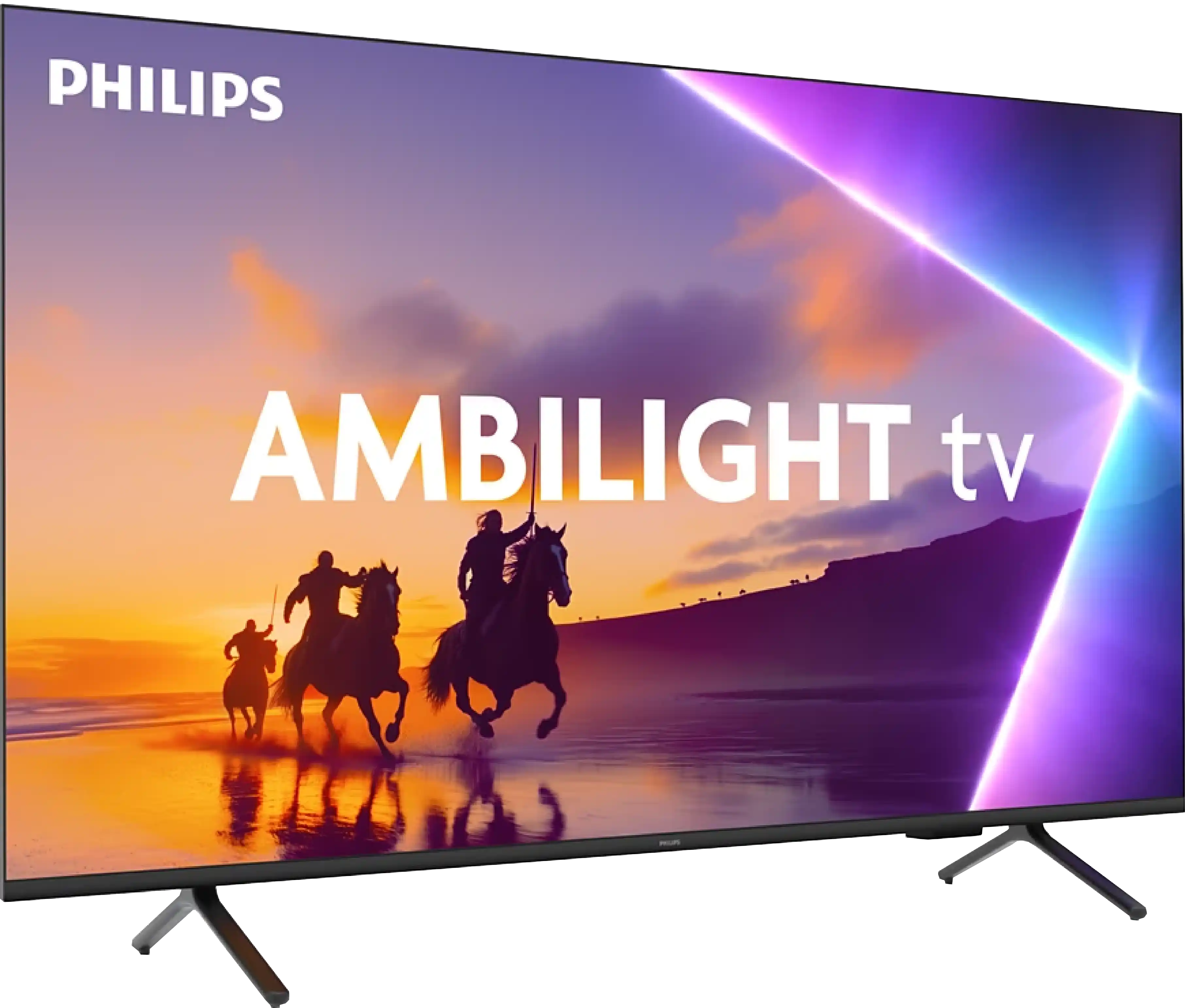
Panel type: LCD VA
Resolution: 3840x2160
System: WebOS
Model year: 2024
Complete the survey to find out the result

Panel type: LCD VA
Resolution: 3840x2160
System: Titan OS
Model year: 2025
Complete the survey to find out the result

Overall rating
6.0
5.6
Movies and series in UHD quality
5.7
5.4
Classic TV, YouTube
5.9
6.1
Sports broadcasts (TV and apps)
5.2
5.2
Gaming on console
6.6
6.7
TV as a computer monitor
5.6
5.6
Watching in bright light
3.9
4.9
Utility functions
8.3
4.9
Apps
9.1
4.6
Sound quality
6.1
6.2
Complete the survey to find out what fits your preferences
Advantages
WebOS system and Magic Remote
High native contrast
Recording to USB
Low input lag values
Good for computer - PC
Ambilight System
High native contrast - VA panel
Low input lag
Basic gaming features: ALLM and VRR
Full support for audio formats: Dolby Atmos and DTS
Backlit remote control with numeric keypad
Disadvantages
Very low brightness
Missing Dolby Vision/HDR 10+
Does not support DTS audio format
Average panel brightness
The TitanOS system seems unfinished (some features do not work, missing applications)
Infrared remote control
Issues with font readability (PC)
Our verdict
Ambilight, as this is what we need to start with, is the biggest reason why it's worth buying the PUS8500. The three-sided backlighting of the television looks fantastic, especially in the evening. It creates an atmosphere, masks contrast shortcomings, and makes watching a film simply more enjoyable. Even if the black levels aren't perfect, the native VA panel offers decent performance at high contrast. Additionally, there’s quite a good input lag and several features for gamers such as ALLM and VRR. Although HDMI 2.1 and a 120Hz panel are absent, playing casually should be a pleasure. Especially since it feels responsive and without delays. Let’s also mention the full support for audio formats – both Dolby Atmos and DTS are included, so soundbar owners can also rejoice.
However, we won't sugarcoat it – this is still a budget television, and at times it’s clearly evident. The brightness is average – not weak enough to prevent viewing, but on an exceptionally sunny day, watching without curtains can be problematic. Nevertheless, in our opinion, the biggest disappointment of the PUS8560 is the Titan OS operating system. Despite the fact that the system debuted some time ago, certain functions simply refused to work – for instance, screen mirroring from a phone despite the manufacturer claiming that such a feature is present. There are fewer apps than in the competition, and the system itself operates rather clumsily. Generally, while it does have some features, it evidently lacks refinement.
Of course, this isn’t a television meant to compete with top models. But if someone is looking for something simple, with a great atmosphere provided by the Ambilight system, it is quite a fair proposition. You just have to know what to expect and accept the numerous compromises present here.
TV appearance




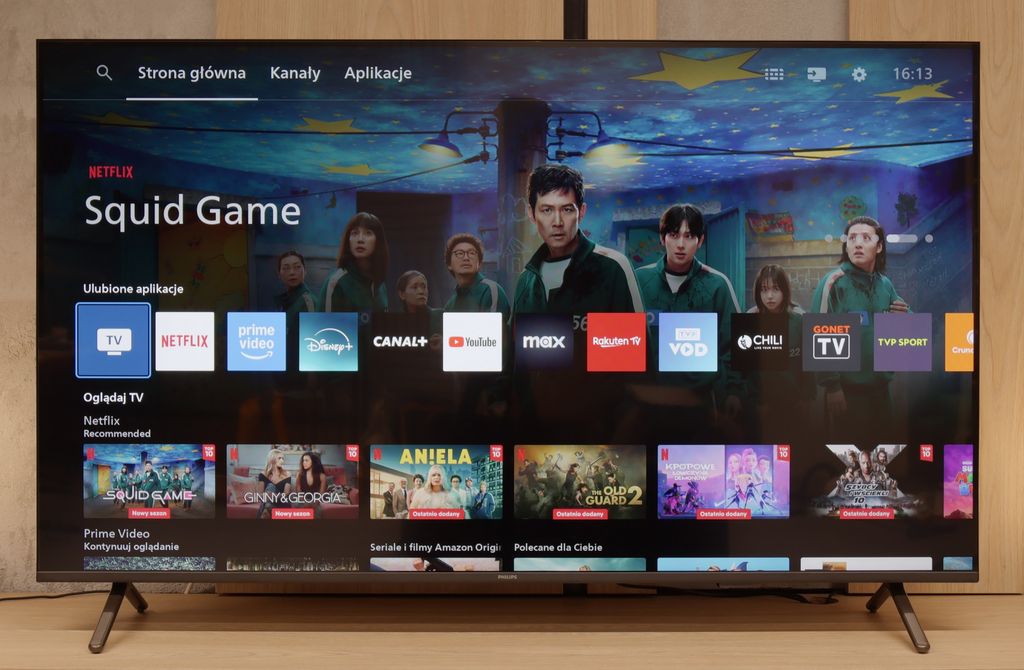
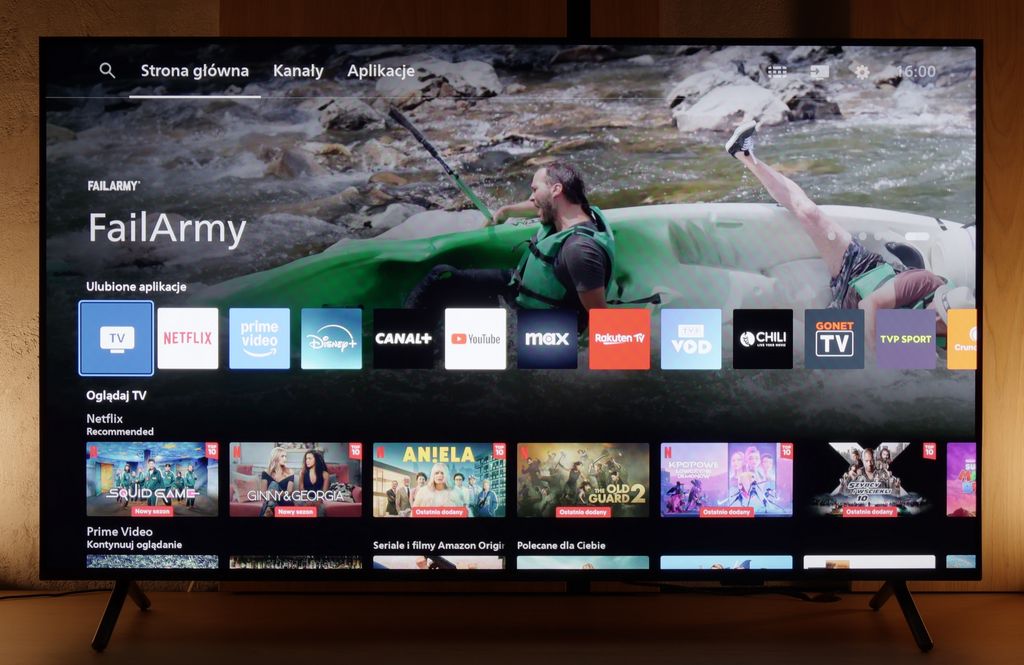
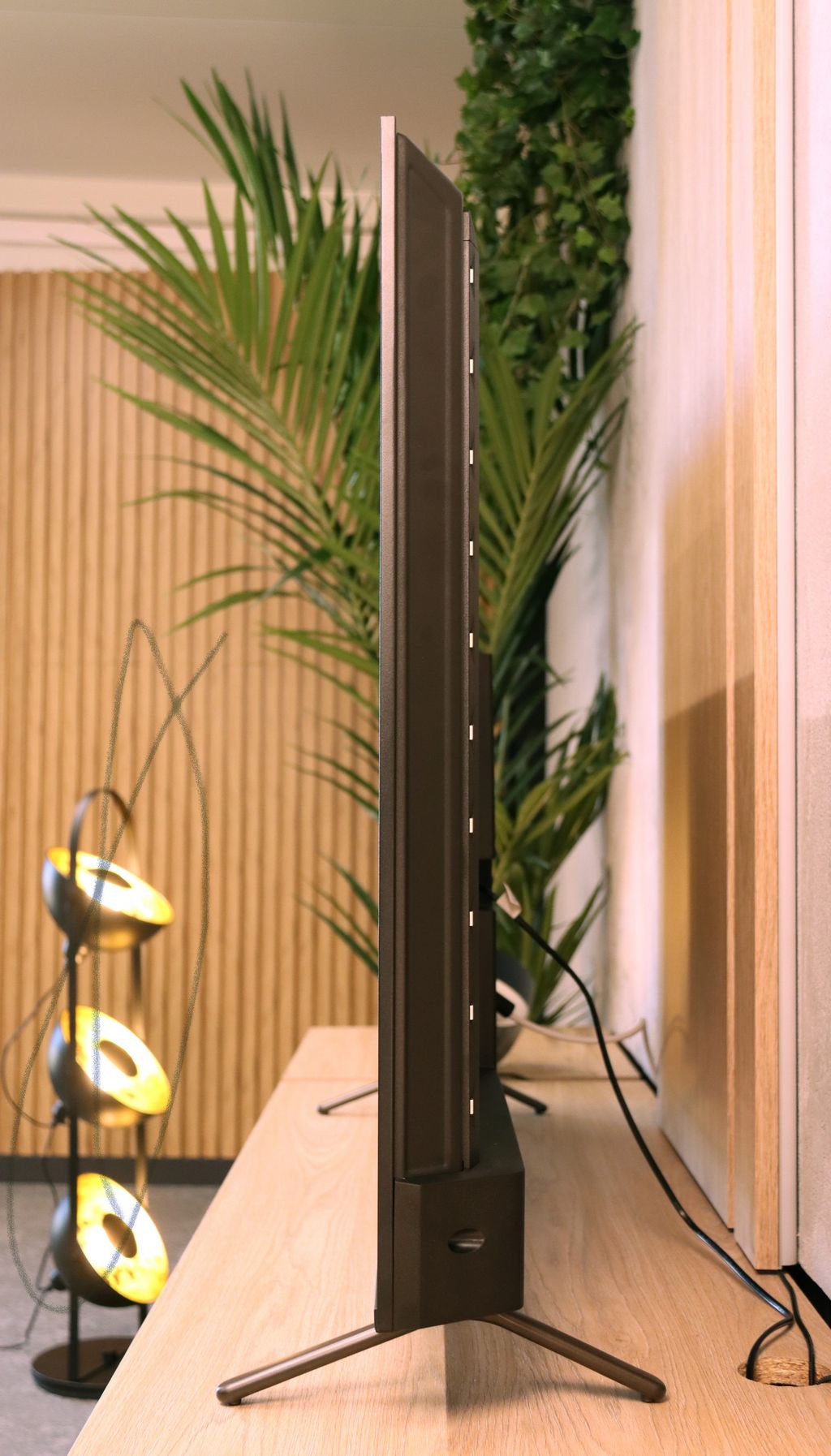
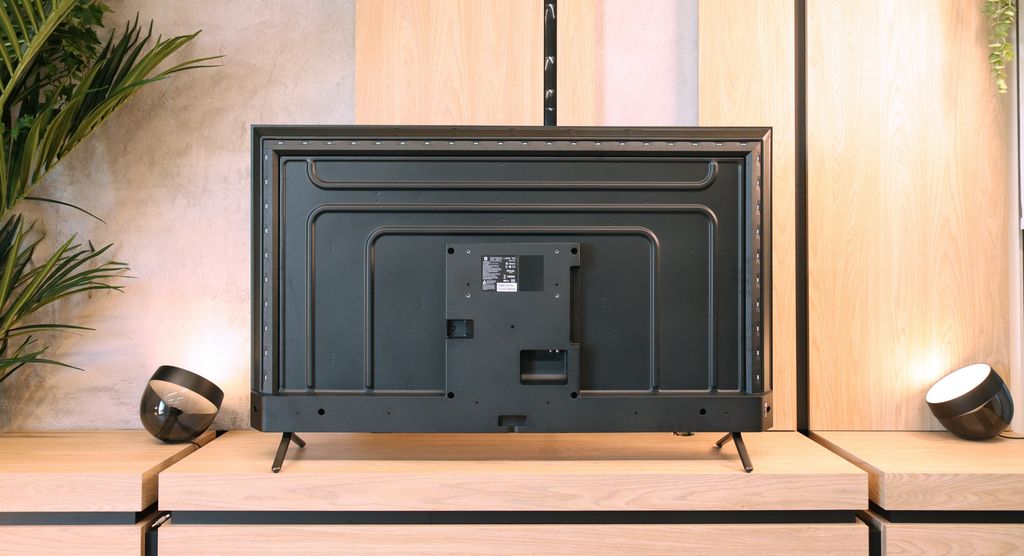
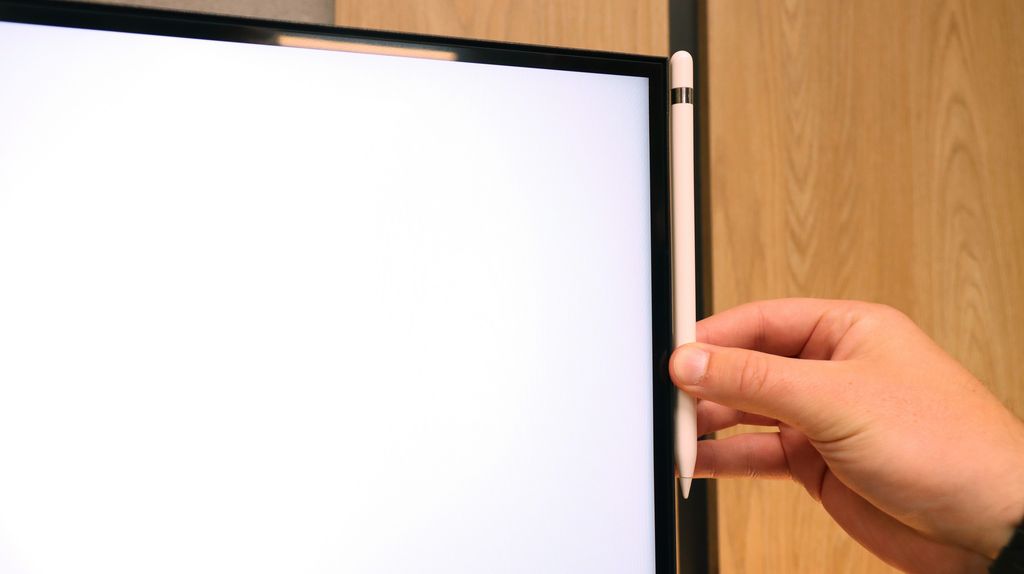
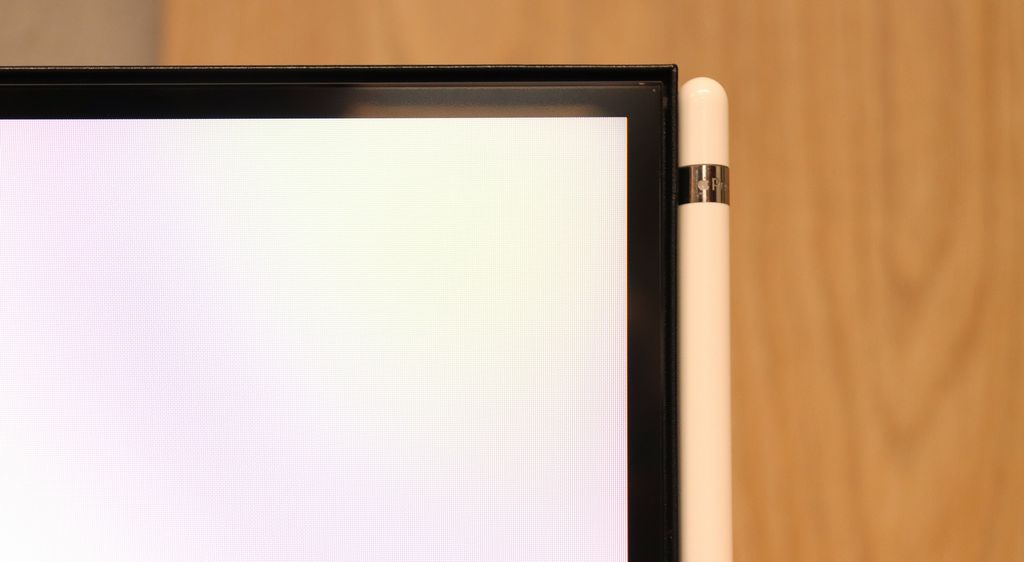

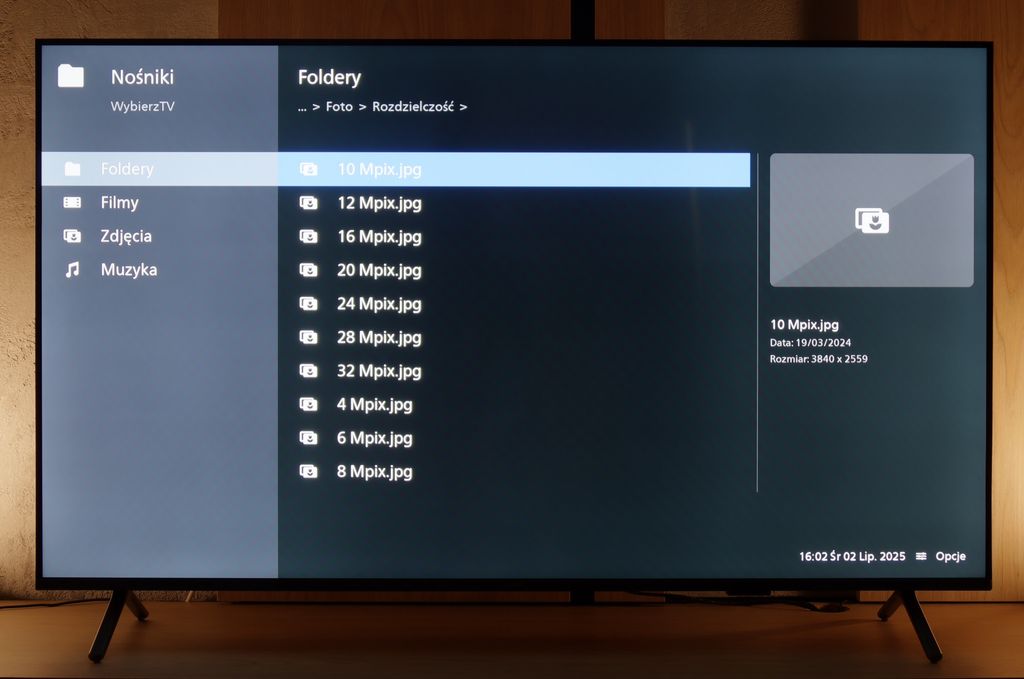
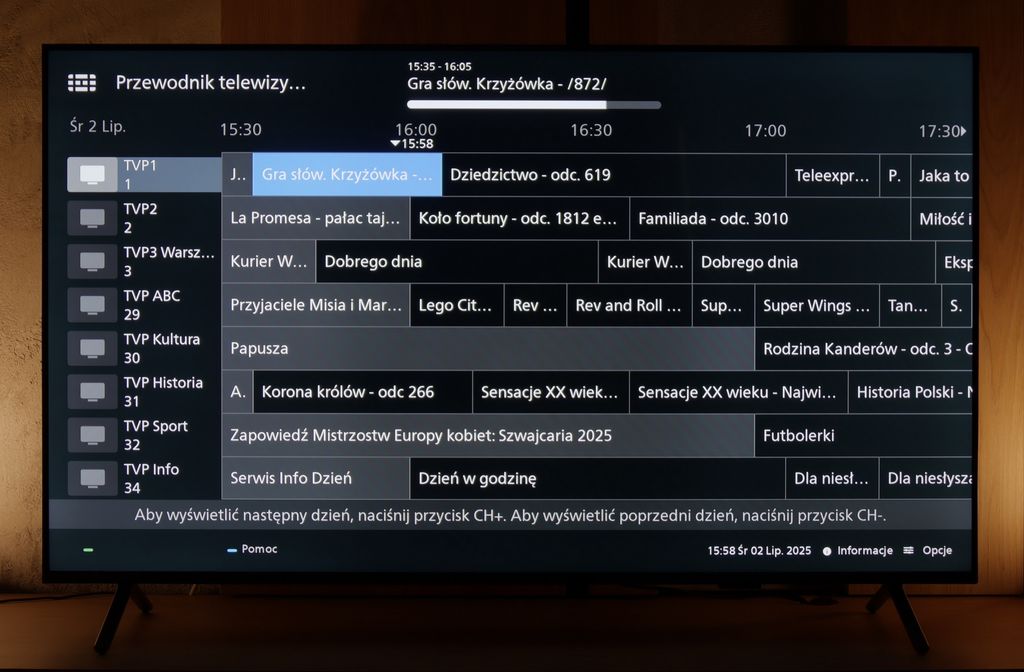
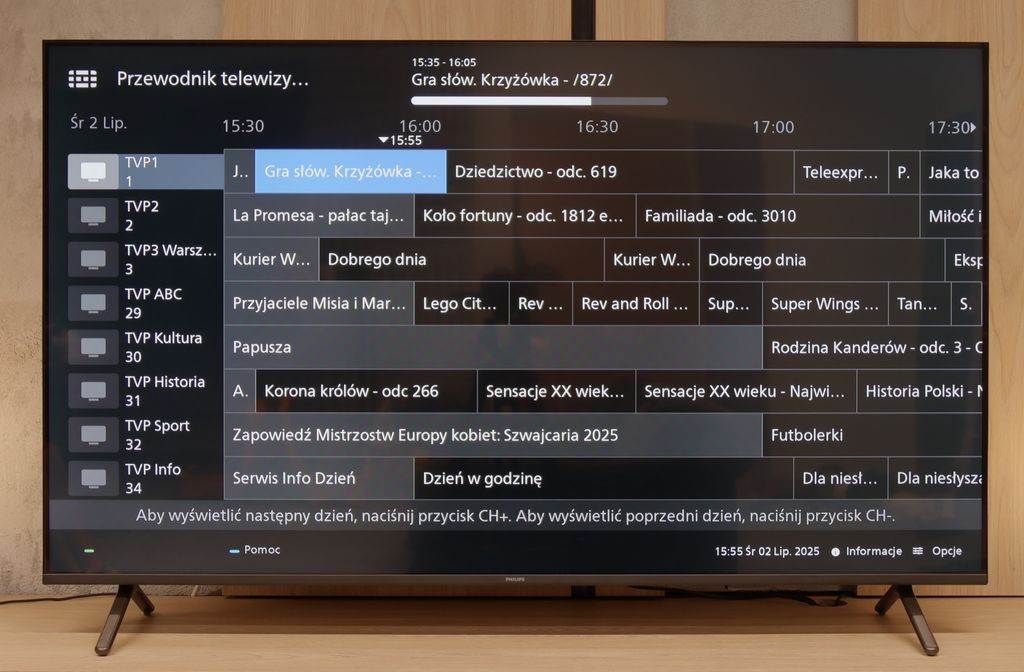
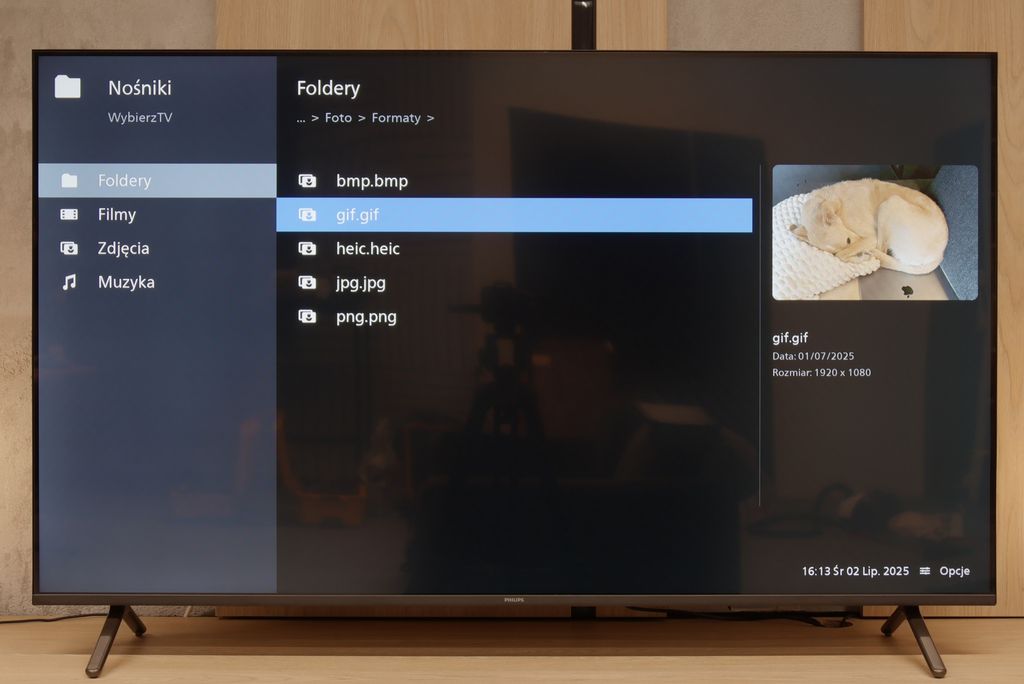
Contrast and black detail
5.3/10
6.1/10
Local dimming function: No
Local dimming function: No
Contrast:

Result
4,150:1

Result
4,250:1

Result
3,800:1

Result
3,700:1

Result
3,800:1

Result
6,000:1

Result
5,950:1

Result
6,250:1

Result
5,950:1

Result
5,750:1
Halo effect and black detail visibility:

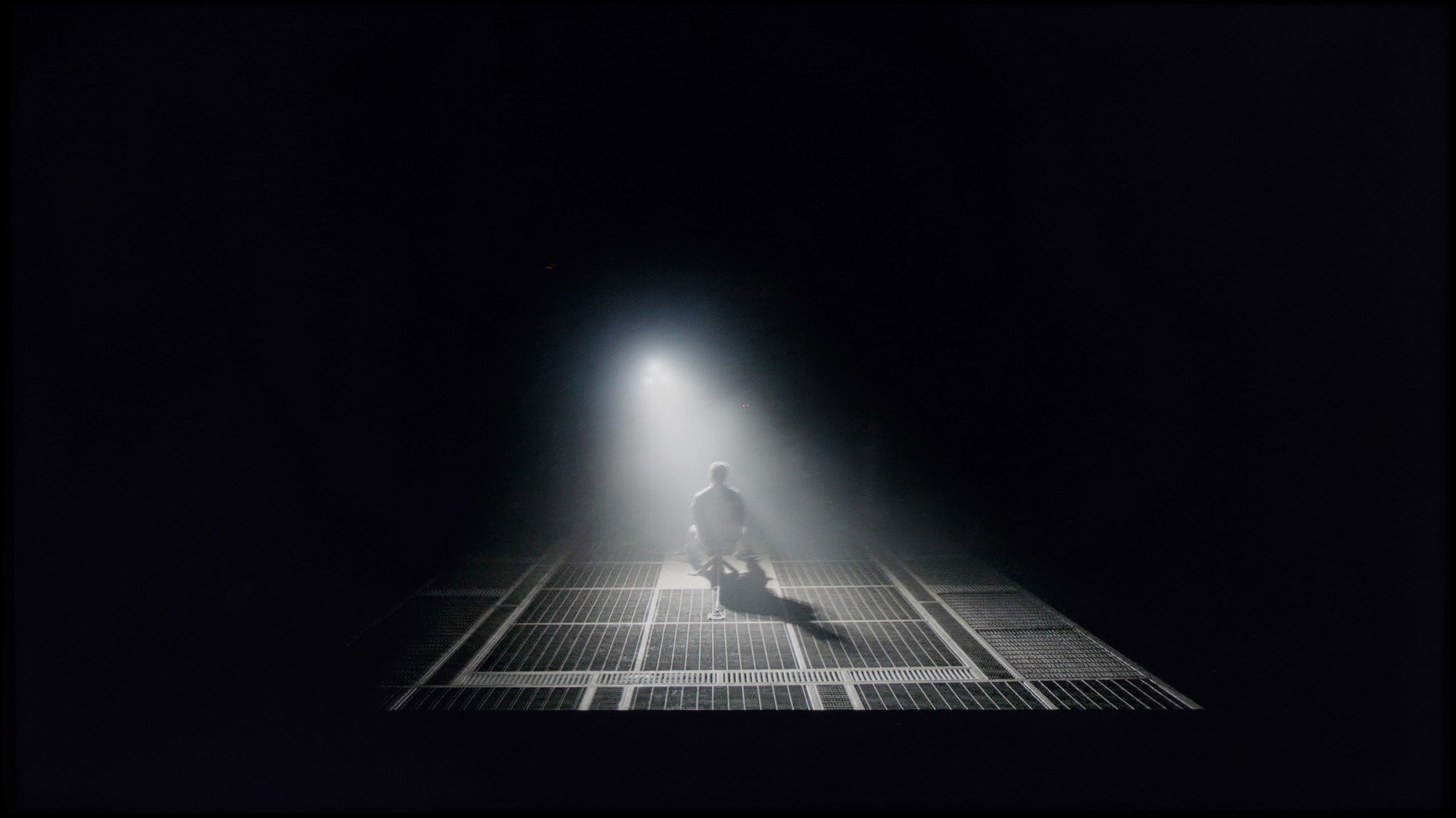
LG NANO82T is equipped with a VA panel, which features quite good native contrast. Compared to IPS panels, VA offers better black depth and higher contrast, making images more vivid and realistic. However, due to the lack of local dimming technology – which is fairly typical in this product category – some limitations of the television can be observed. Since the television cannot turn off specific segments of the screen, there is a lack of the so-called "boost" (flare) of those elements. Black often resembles a dark navy colour rather than deep, absolute black. We can witness this situation in the tested film excerpts, e.g. from the film "Sicario 2". This affects the overall picture quality, especially in darker scenes where details may be less clear.
The Philips PUS8560 in the size we tested is equipped with a VA panel. As a result, black levels – as far as LCD televisions go – can be deemed decent. And that is exactly the case with this model. Both black levels and the overall impression of contrast in the film scenes we tested were really quite good – the image does not bleed, and details are visible even in challenging sections.
But the panel alone is not everything. Unfortunately, the PUS8500 does not come with local dimming (which is a given considering the television segment), so one must be aware that in completely dark conditions, the black can resemble shades of navy more than true black. On the other hand – and here’s a plus for Philips – the Ambilight system does an excellent job. The backlighting genuinely affects the perception of contrast. Therefore, even if technically the black is not perfect, subjectively the viewing experience becomes much more pleasurable. For many people, this is enough to make an evening screening truly impressive.
HDR effect quality
3.7/10
4.1/10
Luminance measurements in HDR:

Result
247 nit

Result
224 nit

Result
282 nit

Result
185 nit

Result
286 nit

Result
273 nit

Result
300 nit

Result
324 nit

Result
343 nit

Result
334 nit
Scene from the movie “Pan” (about 2800 nits)

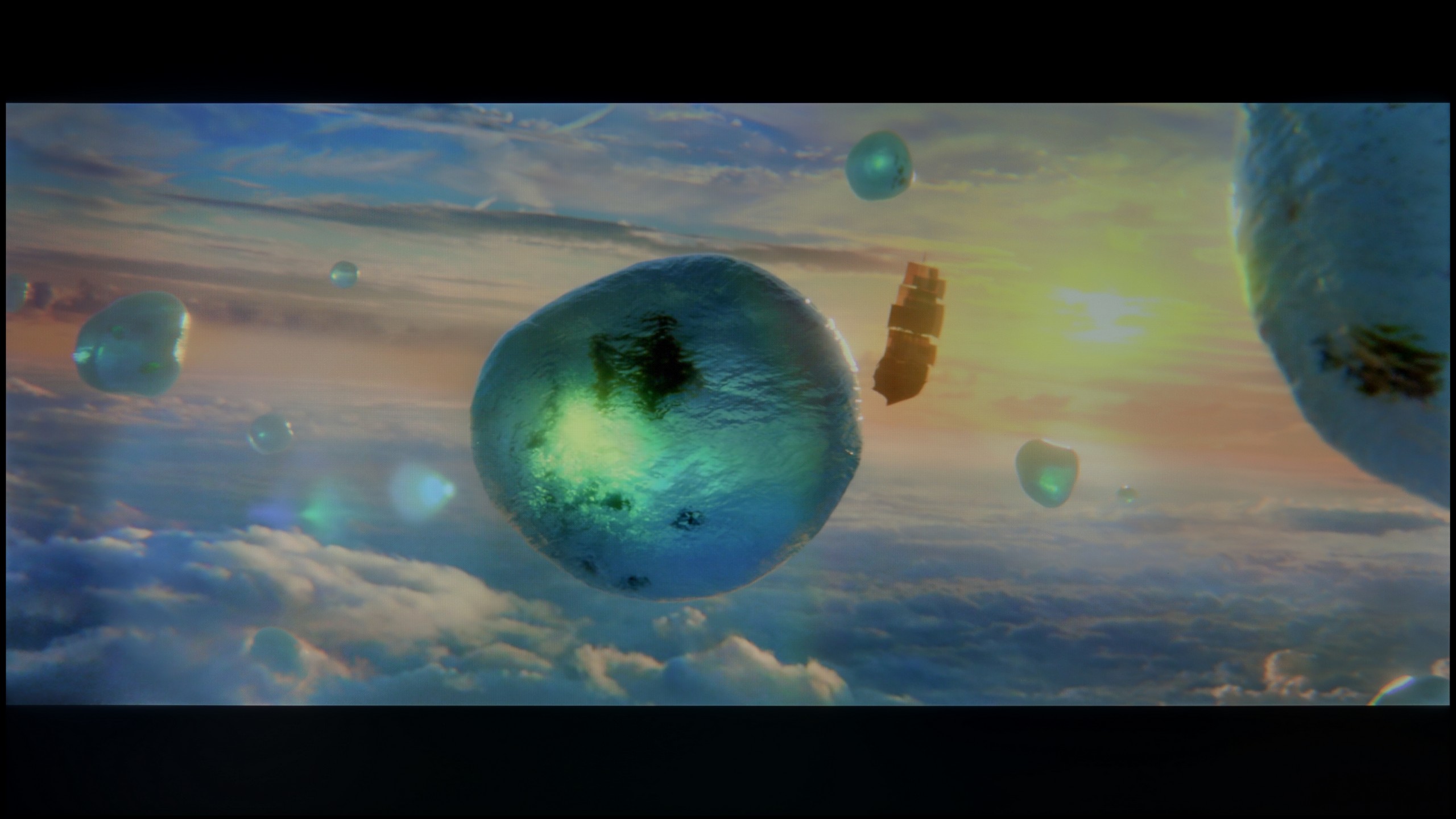
Scene from the movie “Billy Lynn” (about 1100 nits)

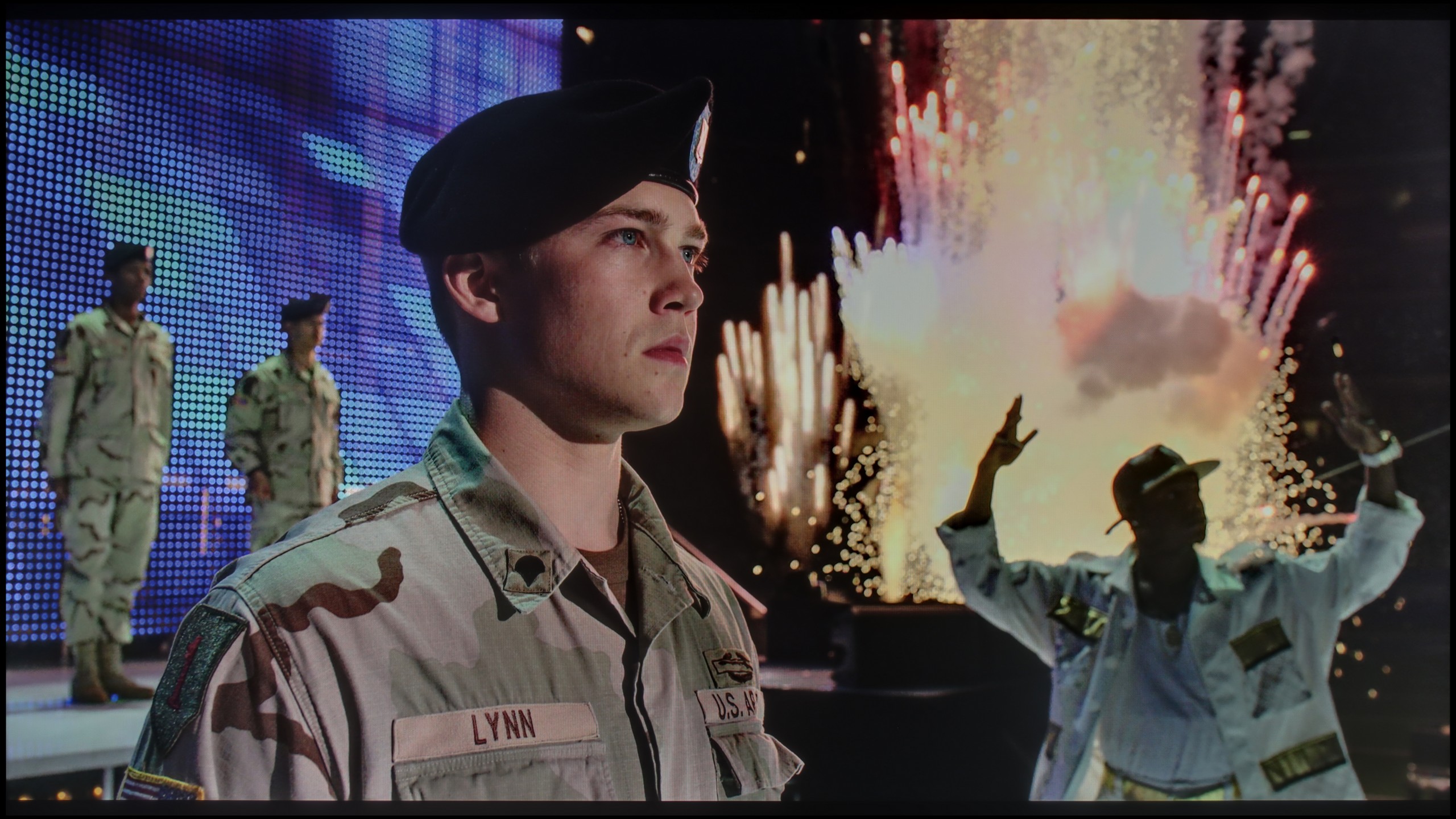
Static HDR10


HDR luminance chart:
Philips PUS8500
Luminancja HDR
Luminance of RGB colors
LG NANO82T6B
Luminancja HDR
Luminance of RGB colors
The brightness of NANO82T, to be honest, is quite average, especially compared to alternatives at a similar price. The maximum brightness of around 280 nits is not among the highest and may affect the overall viewing experience of HDR content. While many televisions in this price range offer brightness above 400-500 nits, LG NANO82T may seem less impressive. As a result, details in bright areas of the image may be less defined, and the HDR effect is not as spectacular as one might expect.
When it comes to the HDR effect on the PUS8560, it can fairly confidently be stated that it is very average. The panel brightness is around 350 nits, which we consider to be the absolute minimum for watching content in this format. However, this is not a result that will astonish a viewer searching for the best possible picture.
On the plus side, it is worth noting that the PUS8500 series – including the PUS8560/12 we tested – is advertised as a QLED television. And indeed, we can expect a wider colour spectrum here. This model is equipped with an additional filter (PFS), and a DCI-P3 colour coverage of around 90% should suffice for the majority of users. This filter works very similarly to quantum dots. As a result, the colours are quite well saturated. It is not an outstanding result, but it is entirely sufficient for watching films and series from streaming platforms.
Factory color reproduction
5.2/10
6.2/10


Factory Mode
After calibration

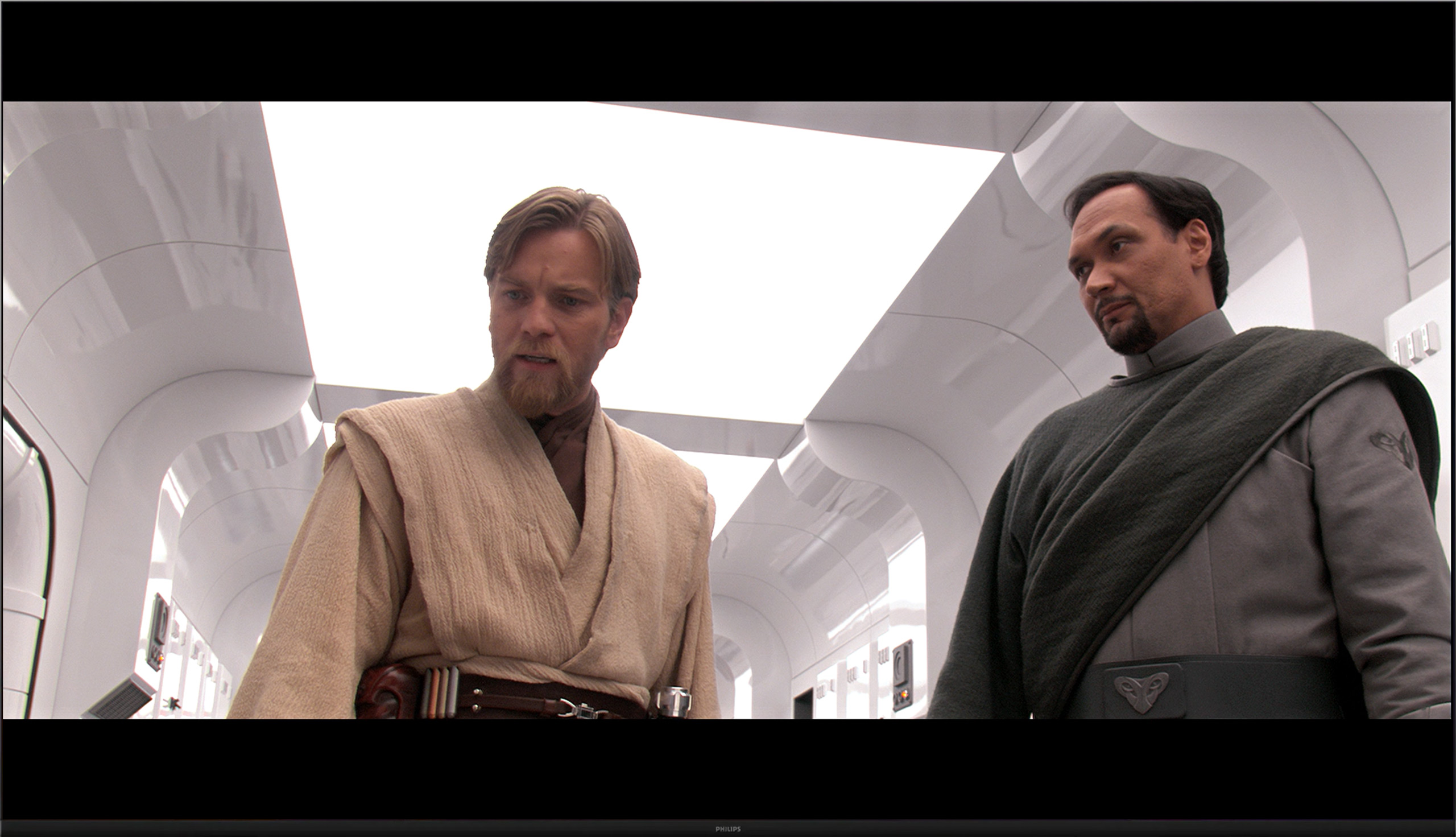
Factory Mode
After calibration
The colour reproduction in LG NANO82T in Filmmaker mode, which although is the best mode available from factory settings, is not without flaws. First and foremost, the issue lies with the white balance, where a drop in blue colour levels was noted on the graph. This phenomenon results in a shift in colours towards yellow shades, causing the image to appear warmer than it should. Such a deviation means that the colours on the screen are not naturally reproduced, and this can be particularly noticeable in scenes with a white or neutral background. For example, the image below from the film "Star Wars," where there is a large amount of elements that should be white. The Color Checker test confirms that some colours are "shifting" to other shades, which means that the television is not displaying colours accurately.
Regarding contrast, the gamma graph analysis showed drops to a level of 2.1, while the optimal value should be 2.4. This means that the television may display darker areas of the image brighter in some scenes, reducing their depth and dynamics. Additionally, on the EOTF curve, which is responsible for brightness reproduction, a slight spike was noted at the beginning. This phenomenon may result in excessive brightness boosting in the brightest parts of the image, leading to a loss of detail in very bright scenes.
We tested the television with the best available factory settings, namely in Film/Filmmaker mode – this is the mode we recommend for everyday viewing. Unfortunately, it is not without its flaws. Both in HD and HDR content, the image had a noticeable tendency to a pink tint, caused by an excessive amount of red and blue in the white balance. Another issue turned out to be excessive brightness in the image, which was confirmed by both the gamma chart and the EOTF curve. This feature was responsible for loss of detail and washed-out colours in more challenging HDR scenes that we mentioned earlier. The overall result led to significant colour reproduction errors – in extreme cases, the delta E value exceeded 7, while the threshold for visible errors for the human eye is around 3. This situation can be improved with calibration, and you can read about its effects below.
Color reproduction after calibration
7.6/10
8.4/10

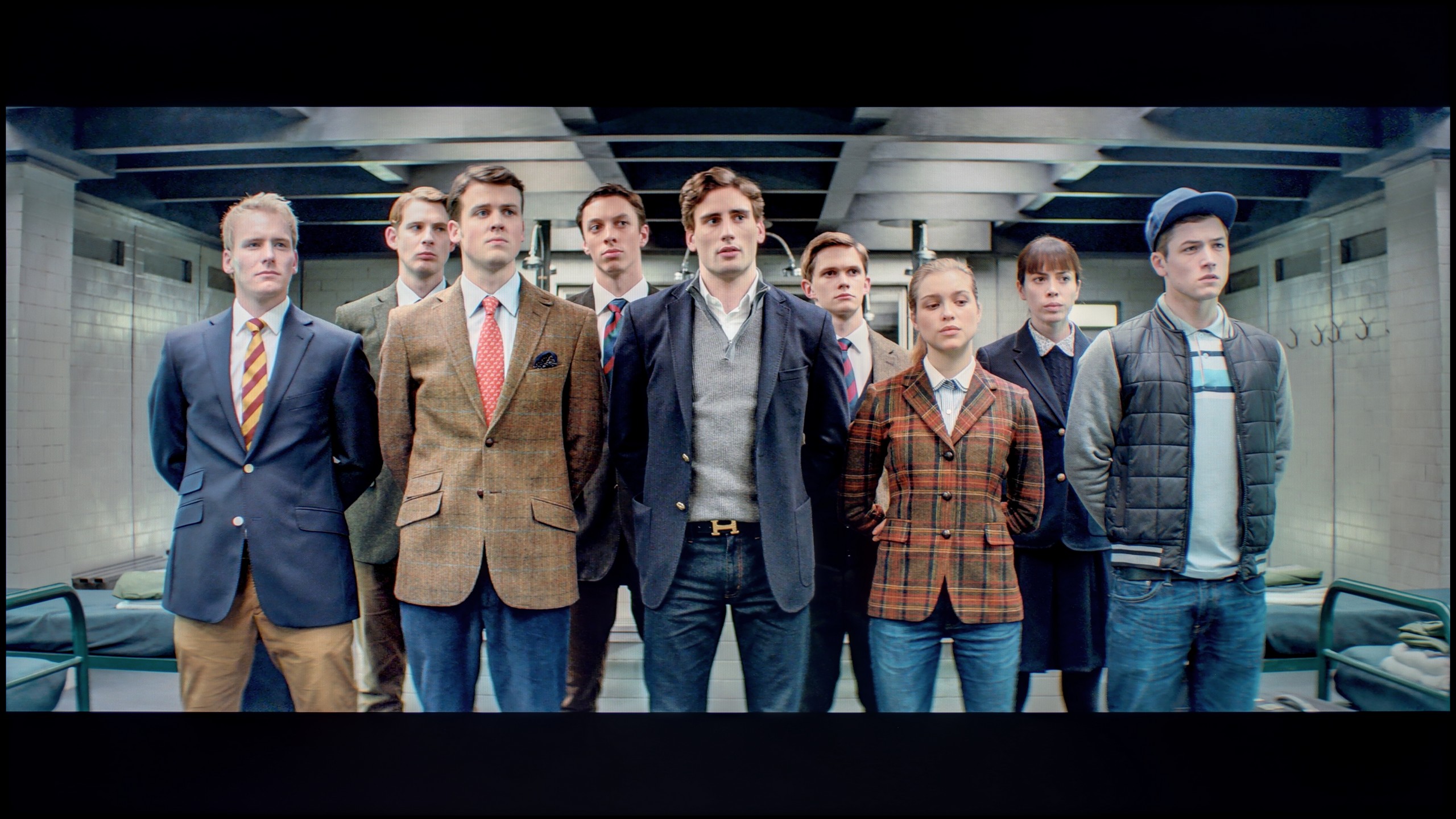


After calibration, the colour reproduction in SDR content on the LG NANO82T is very good. The white balance has been effectively improved, resulting in natural and balanced shades across various scenes. The gamma has also been adjusted, providing a more precise rendering of details both in shadows and bright parts of the image. Thanks to these adjustments, the television performs excellently in everyday use, offering solid colour quality and clear, well-balanced images in SDR mode.
However, in the case of HDR content, the situation is worse. The television does not support a wide colour gamut, limiting the depth and richness of colours that HDR can offer. The EOTF curve deviates from the ideal, leading to excessive accentuation of details in bright parts of the image. Unfortunately, this results in significant colour reproduction errors, as confirmed by tests on the Colour Checker. The low brightness level of the panel further negatively impacts the quality of HDR images, causing dynamic range effects to not be fully realised, and colours to appear washed out.
The television has significantly improved after calibration, especially in SDR content. The improvement in white balance and gamma has greatly enhanced image quality, providing a more natural and coherent colour reproduction. Compared to the pre-calibration state, the difference is noticeable, and the television now offers better performance in everyday use, particularly in the standard dynamic range.
The Dutch manufacturer offers quite a sizable amount of settings in its products, so as usual, we decided to tinker with them a bit. The effects are immediately noticeable – we managed to correct the white balance, which made the image stop appearing excessively pink. The brightness characteristic has also been partially evened out, of course, within the limits set by the television itself. The image is no longer overly exaggerated, and the overall reception after calibration is definitely better than in the factory settings of the Filmmaker mode.
One could only critique the EOTF curve characteristic, which still indicates that the image has a tendency to brighten HDR materials. Despite our efforts, the darkest parts of scenes are still sometimes too bright, and the brightest ones do not always achieve their full contrast potential. However, it must be clearly stated that we are dealing with a typically budget construction – one cannot expect reference-level reproduction of HDR content from it.
Calibration has definitely helped this model – it improved the balance, toned down the aggressive colour palette, and brought the image closer to what one might expect from a well-configured movie mode. However, there are certain limitations that cannot be overcome.
Smoothness of tonal transitions
8.9/10
6.3/10

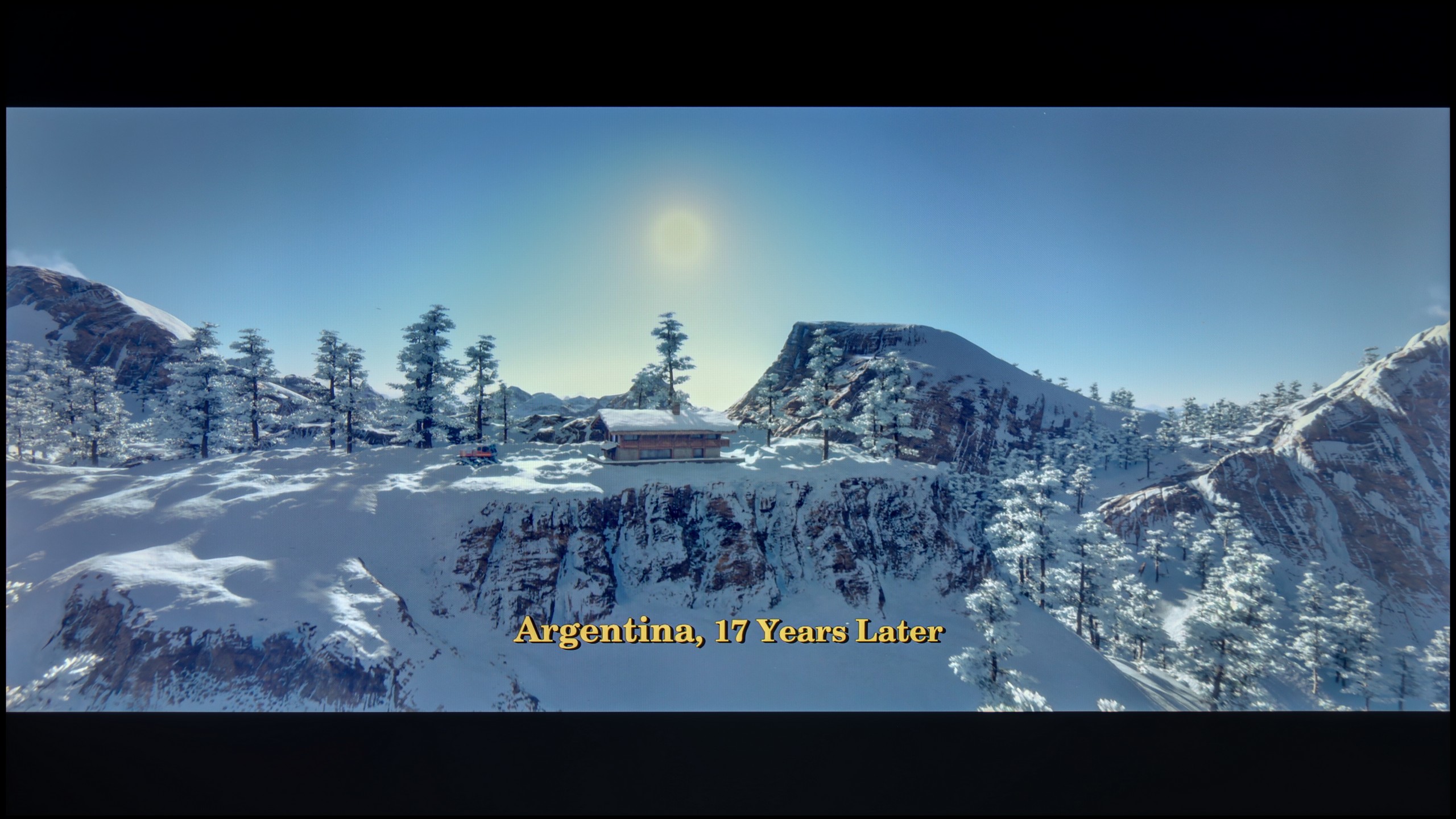

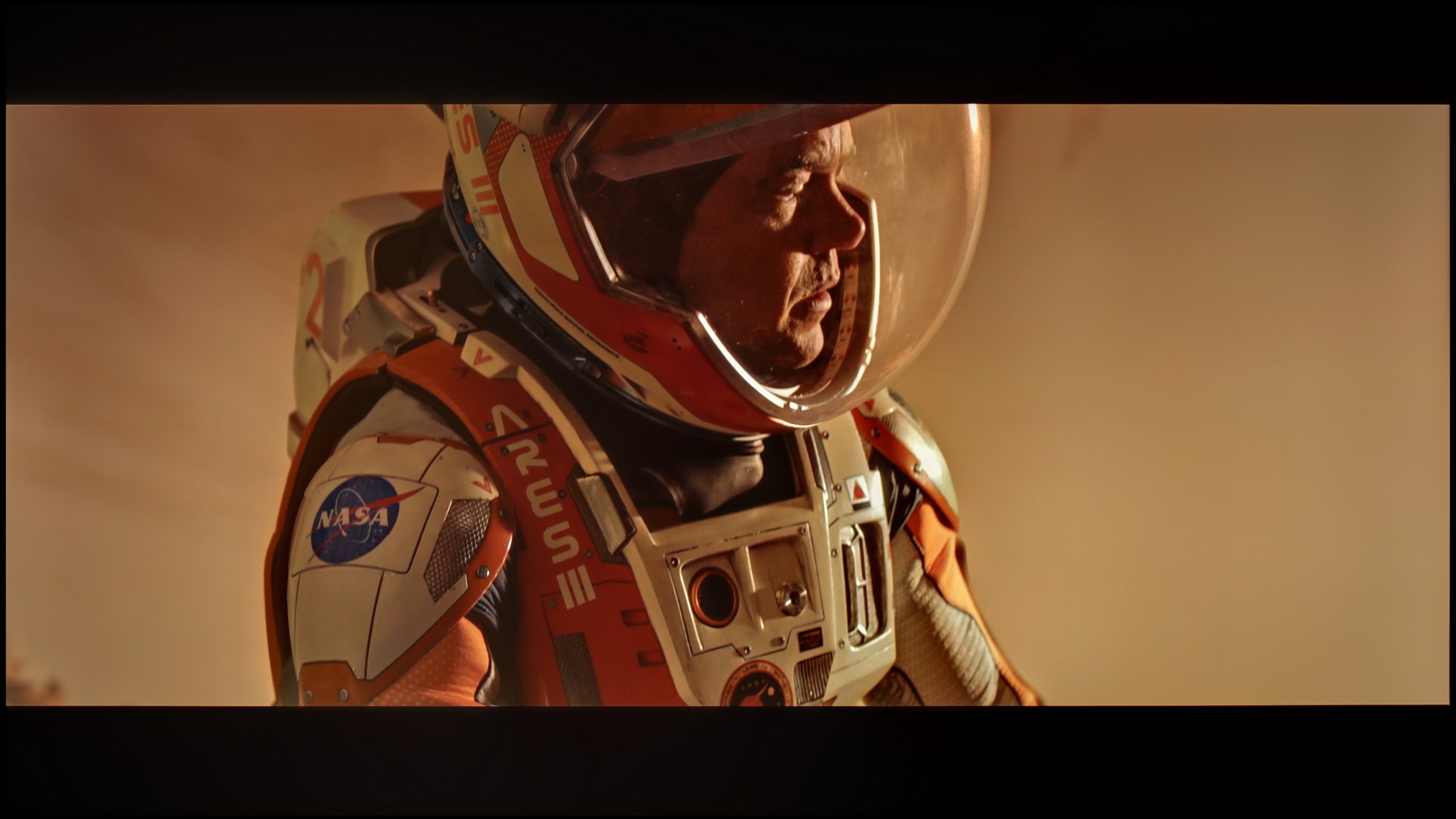

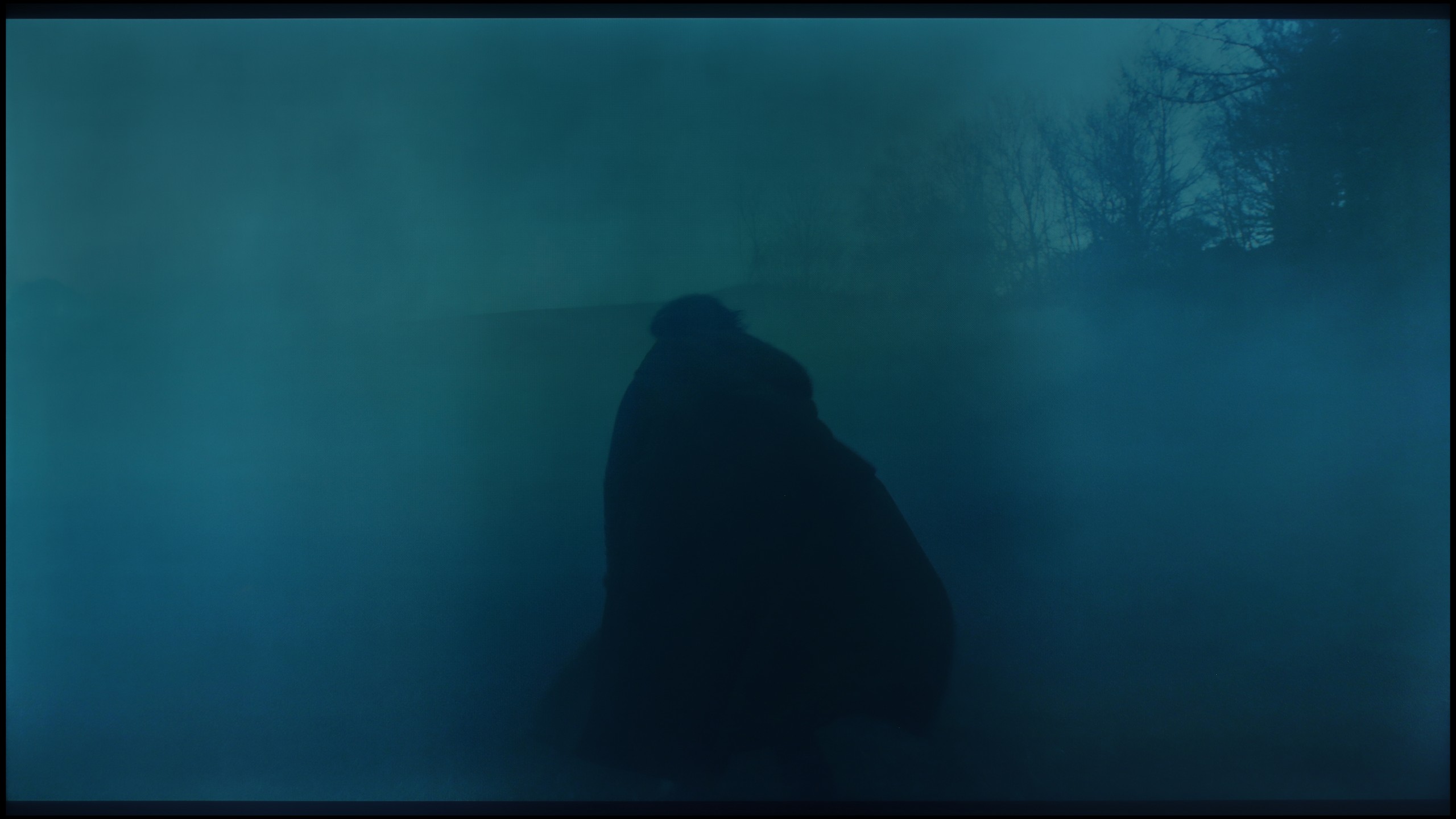

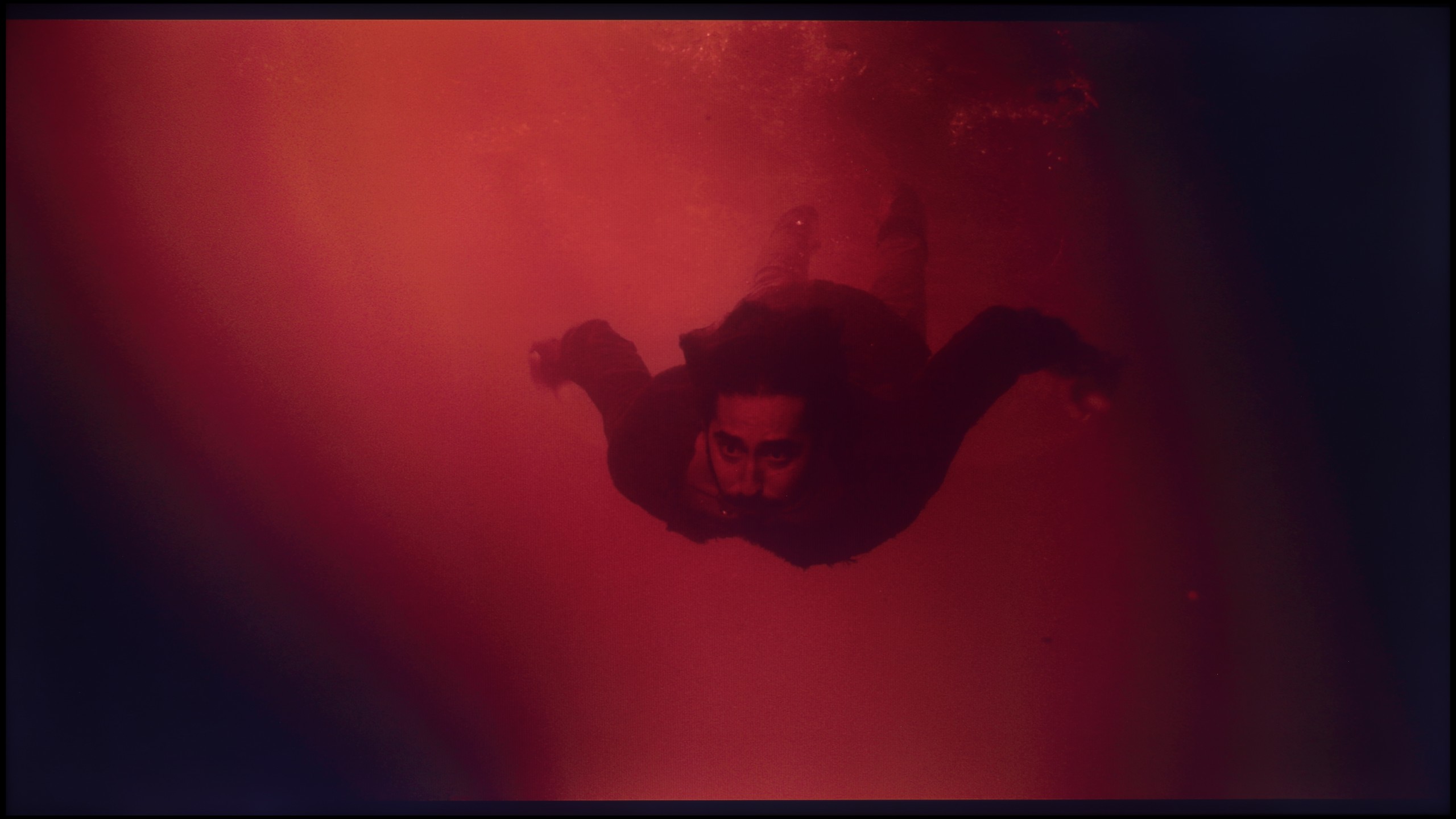




The television handles tonal transitions smoothly, providing high image quality in every scene. Problems with gradation occur sporadically, mainly in darker shades, but they are subtle enough that most viewers will not notice them. Only those with exceptionally keen eyesight may detect these minor imperfections.
The PUS8560 handles colour transitions into smooth gradients very well. During tests, the image appeared coherent and natural, and serious issues with tonal transitions occurred only in very dark scenes – for example, in a shot with red water, where subtle cuts between colours could be noticed. However, these are rather exceptions that do not spoil the reception of most content. It is worth mentioning another phenomenon that more significantly affects the quality of the image – the so-called dithering, which refers to a slight "tingling" visible on uniform backgrounds. This effect can be particularly noticeable in high-quality materials and can somewhat spoil the impression of image clarity. It is for this flaw that we deducted some points in our evaluation.
Image scaling and smoothness of tonal transitions
6.4/10
6.1/10
Smooth transition function

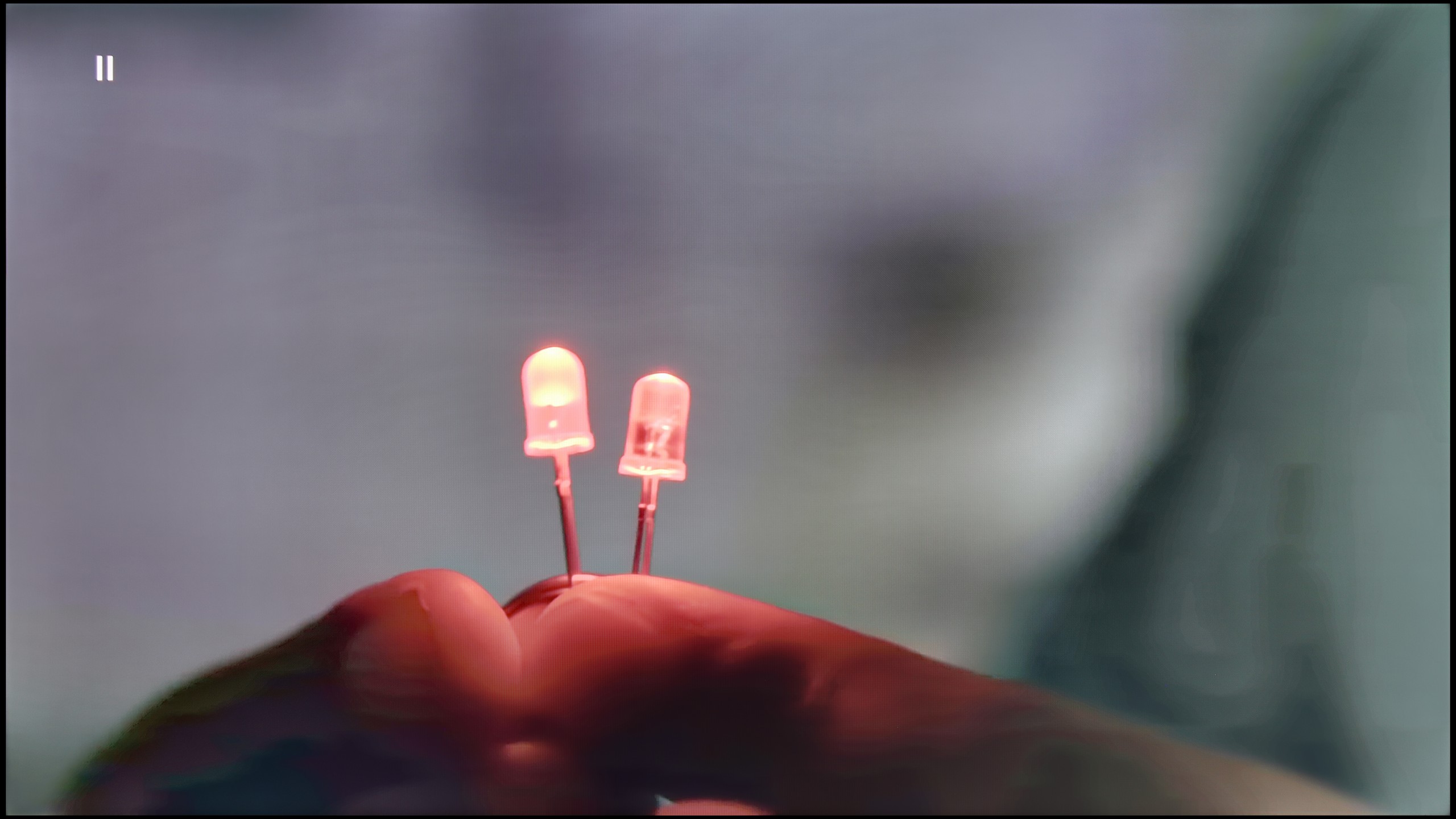
Image without overscan on the SD signal


When it comes to gradation in very low-quality materials, LG NANO82T offers us the option of a feature called "Smooth Gradation". In the "Low" setting, this function slightly improves the most problematic tonal transitions, which is noticeable and useful for such content. In the "High" setting, it works even more effectively, improving tonal transitions, but at the expense of smoothing out those details that should not be smoothed. It is a compromise that may not please all users.
As for image scaling, NANO82T is not without certain limitations, especially when playing content with a lower resolution. The television applies a subtle, artificial sharpness boost, which makes the image appear sharper. This effect mainly results from the overlay of artificial contours. For some users, this may be beneficial, as they prefer more pronounced and highlighted details. However, for those who value the naturalness of the image, this effect may turn out to be less appealing and too artificial. It's a subjective matter that may affect viewers differently, depending on their visual preferences.
Philips PUS8560 offers a function for reducing posterization, hidden under the name "distortion reduction". And although it indeed fulfills its role by smoothing out problematic tonal transitions, it works a bit too broadly. In practice, it affects not only colourful gradients but also softens faces, the textures of clothing, and the surfaces of furniture. This compromises the authenticity of the image – especially in films where natural texture is very important. However, if someone is looking for smoothing at all costs, it's best to set this option to "Low". For cinema image enthusiasts – we definitely do not recommend it.
On the positive side, the quality of upscaling older materials is noteworthy – the PUS8560 model handles them surprisingly well. The image retains its natural softness, without artificially boosted sharpness. It is also worth mentioning that the television correctly displays content with very low resolution, avoiding issues with image edge cutting (so-called overscan).
Blur and motion smoothness
4.8/10
4/10

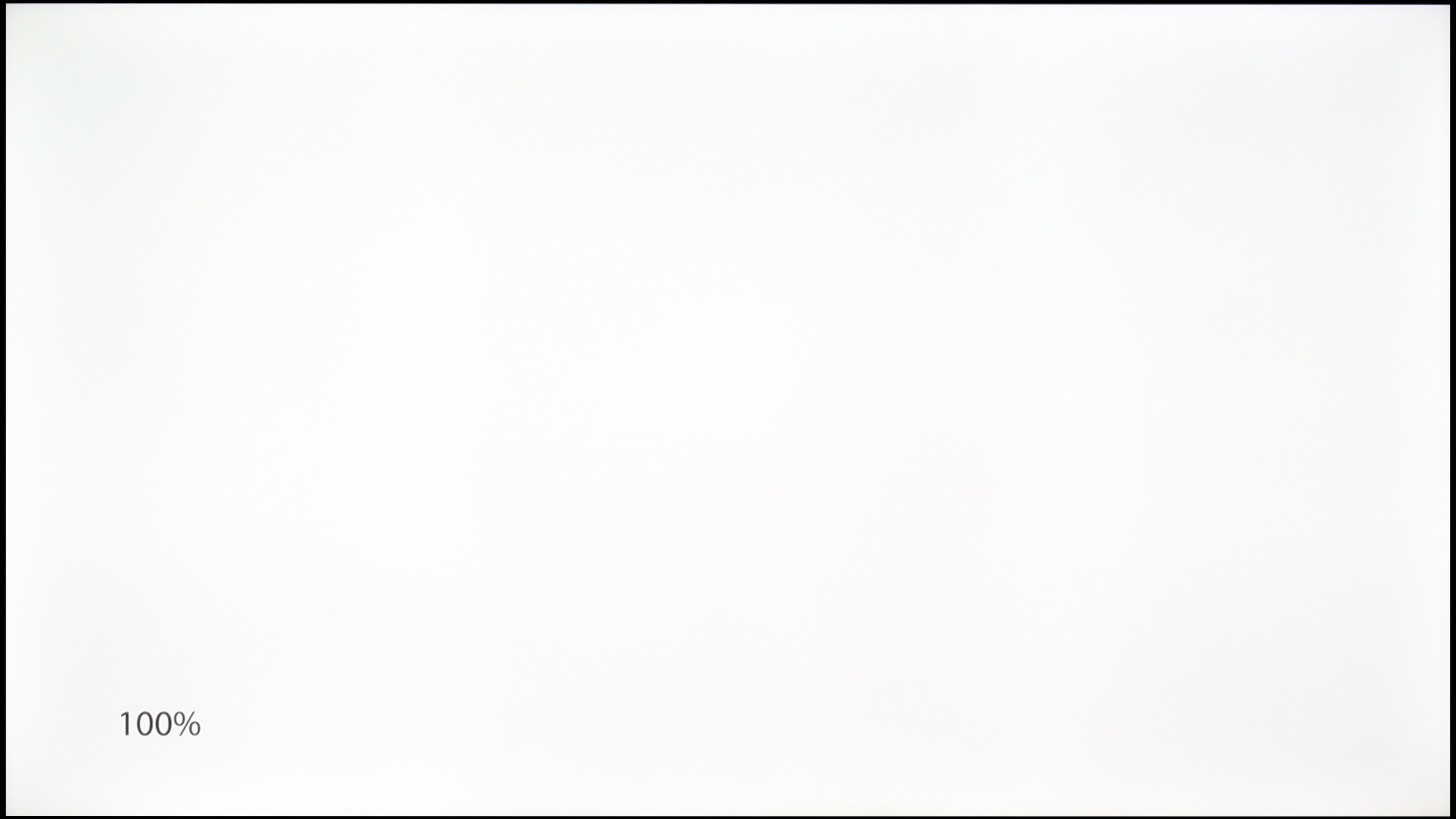
Blur (native resolution, maximum refresh rate):



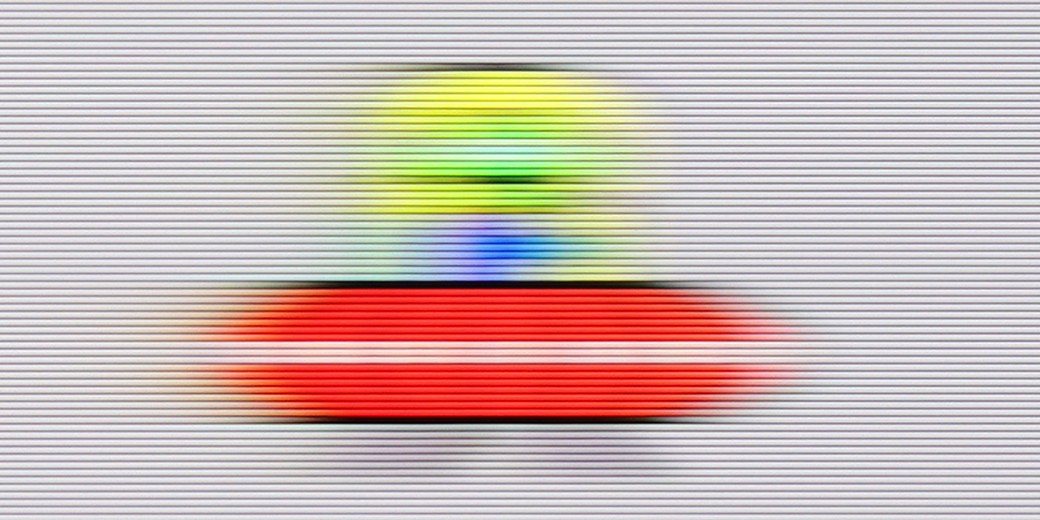
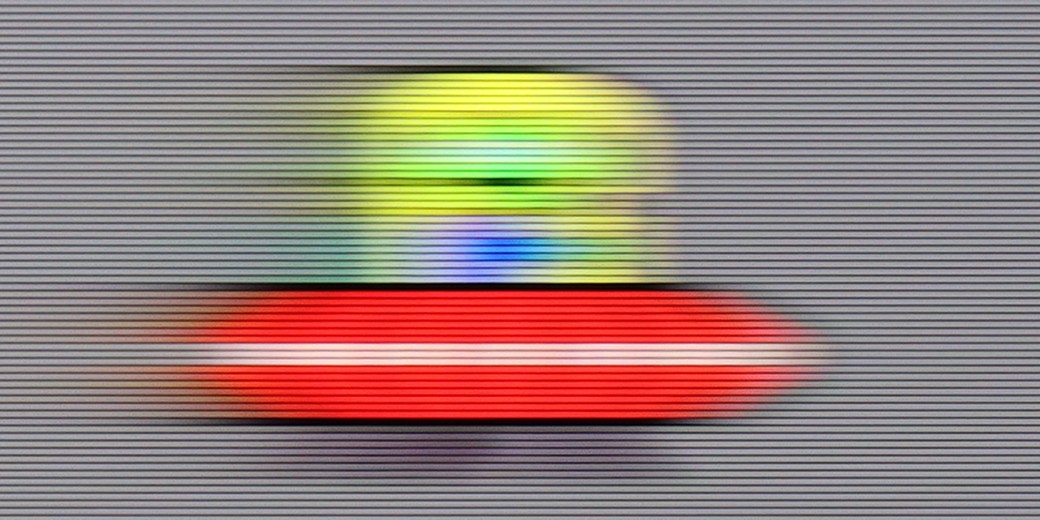
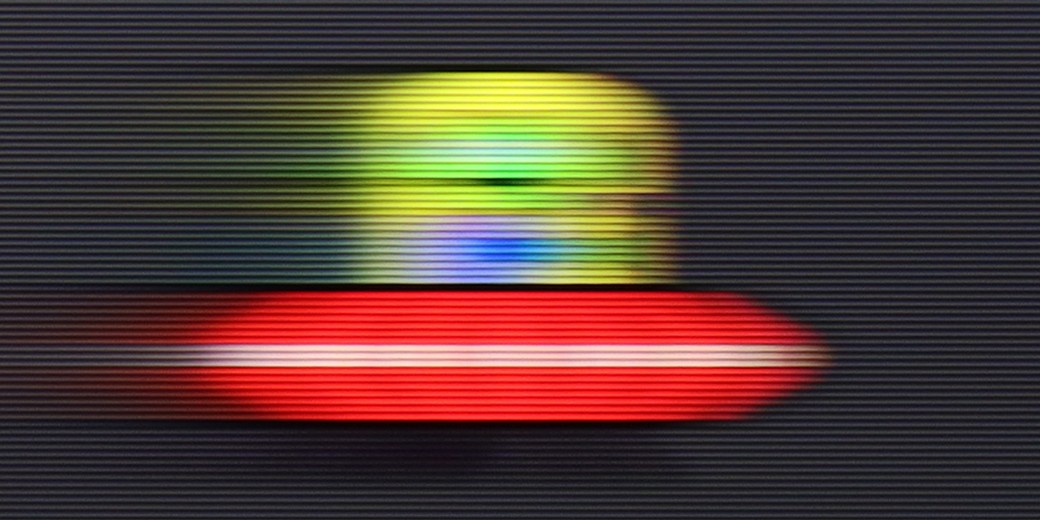
LG televisions, including the NANO82T, offer an interesting motion smoother called TruMotion, which will satisfy most users who value control over the quality of the films they watch. The TruMotion feature allows users to adjust the fluidity of the displayed films on a 10-point scale, enabling the personalisation of visual experiences.
However, in the case of more dynamic scenes, such as games or action films, the television performs worse. The 60Hz panel and relatively slow pixel response result in less than ideal motion smoothness. The effect is visible blurring and less smooth display of fast scenes.
Overall, the LG NANO82T should please those who mainly watch films and prefer more subdued content. However, for those who value dynamic, fast motion, we recommend looking for an alternative.
The Philips PUS8560 is a television equipped with a panel featuring a refresh rate of 60 Hz, which immediately limits its capabilities in terms of displaying dynamic content. Watching sports or playing on a console is not particularly enjoyable. The situation is further worsened by the lack of any option to improve the smoothness of films. In the menu, we won't find settings that would allow us to enable a motion smoother or even a slight motion smoothing for films recorded at 24 frames per second. You can imagine the effect. The image can appear jerky, especially in shots with panoramic camera movements.
Console compatibility and gaming features
4.7/10
4.7/10
- ALLM
- VRR
- VRR range48 - 60Hz
- Dolby Vision Game Mode
- Correct implementation of HGIG
- 1080p@120Hz
- 1440p@120Hz
- 4K@120Hz
- Game bar

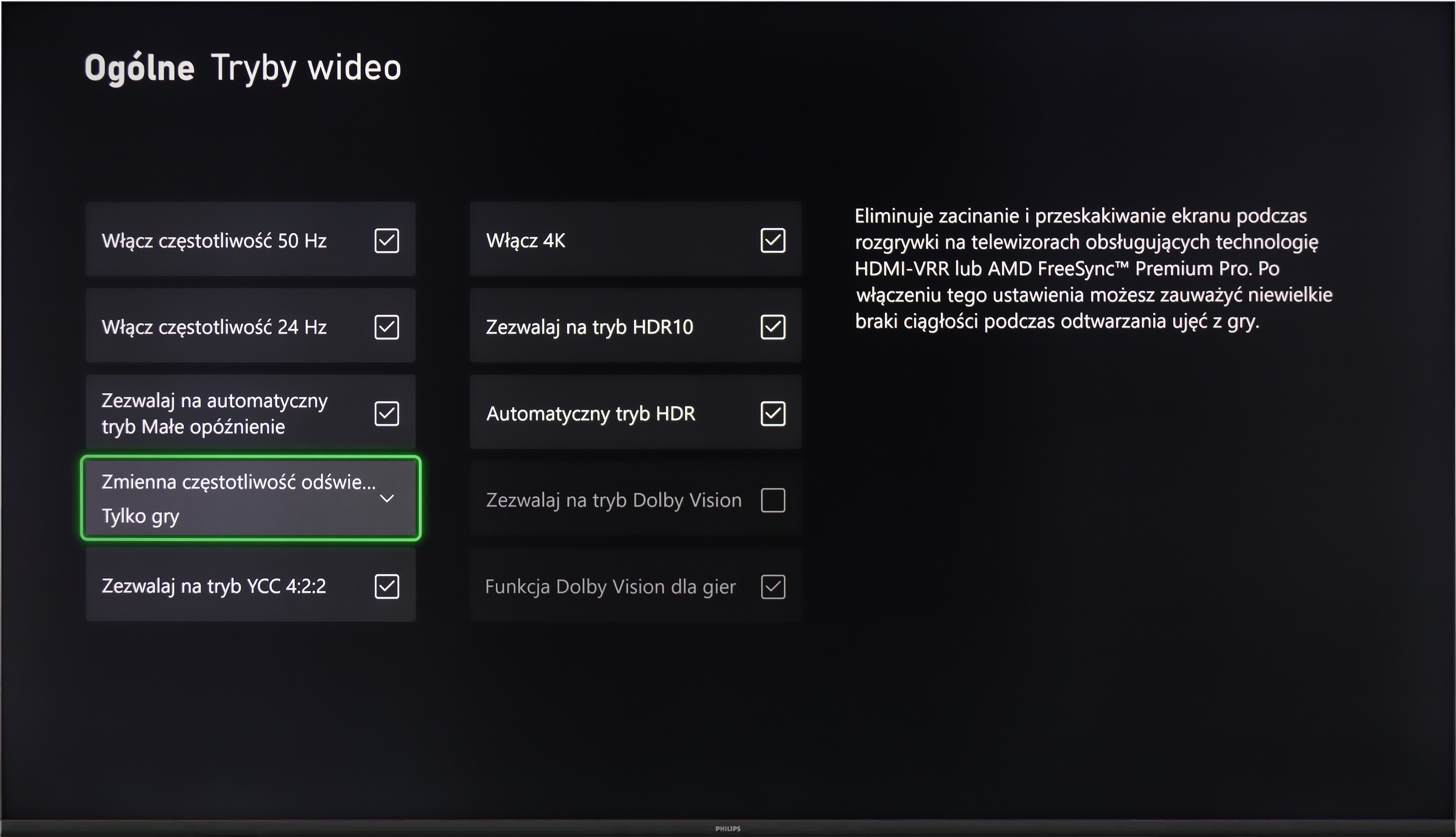

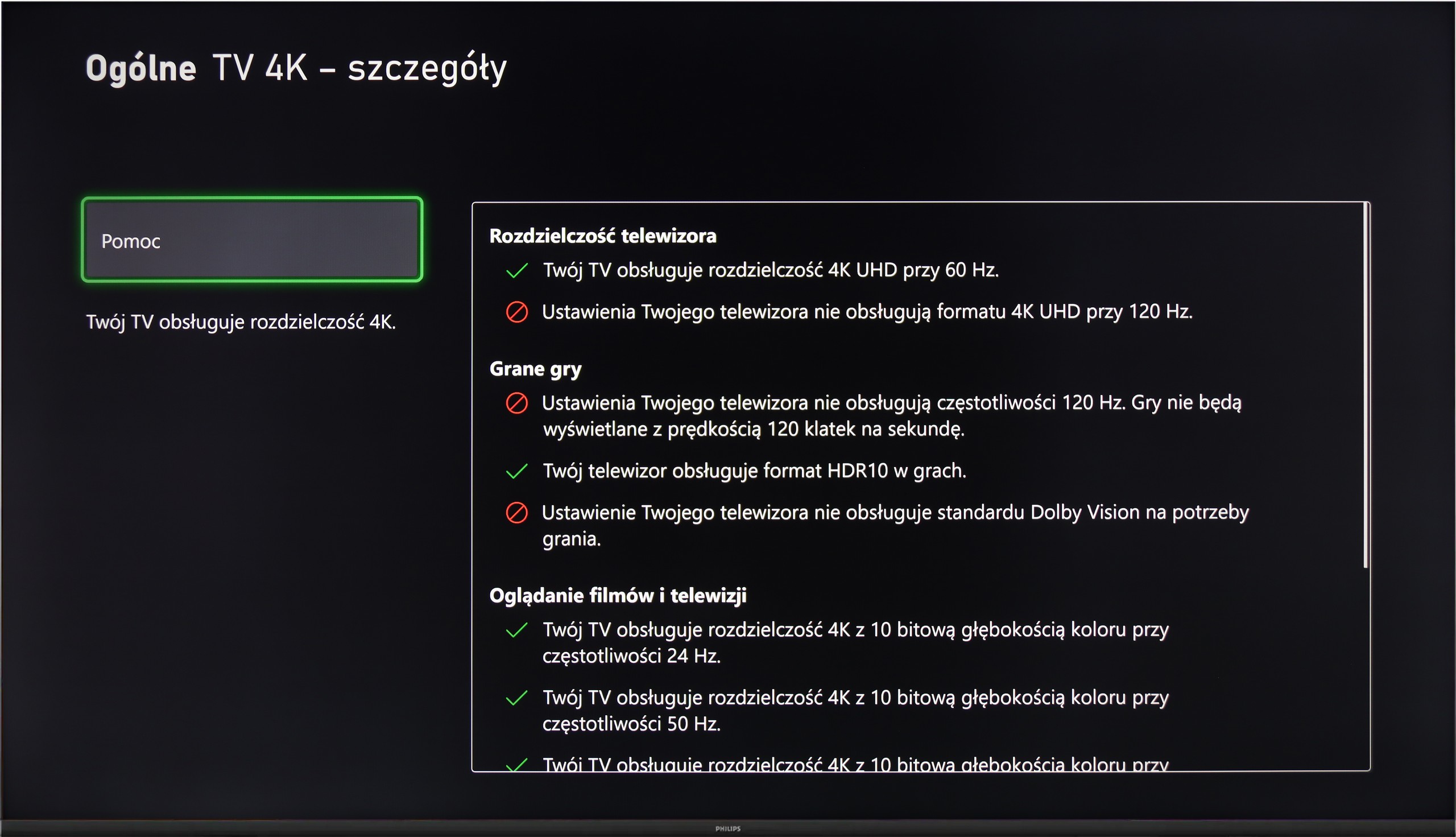

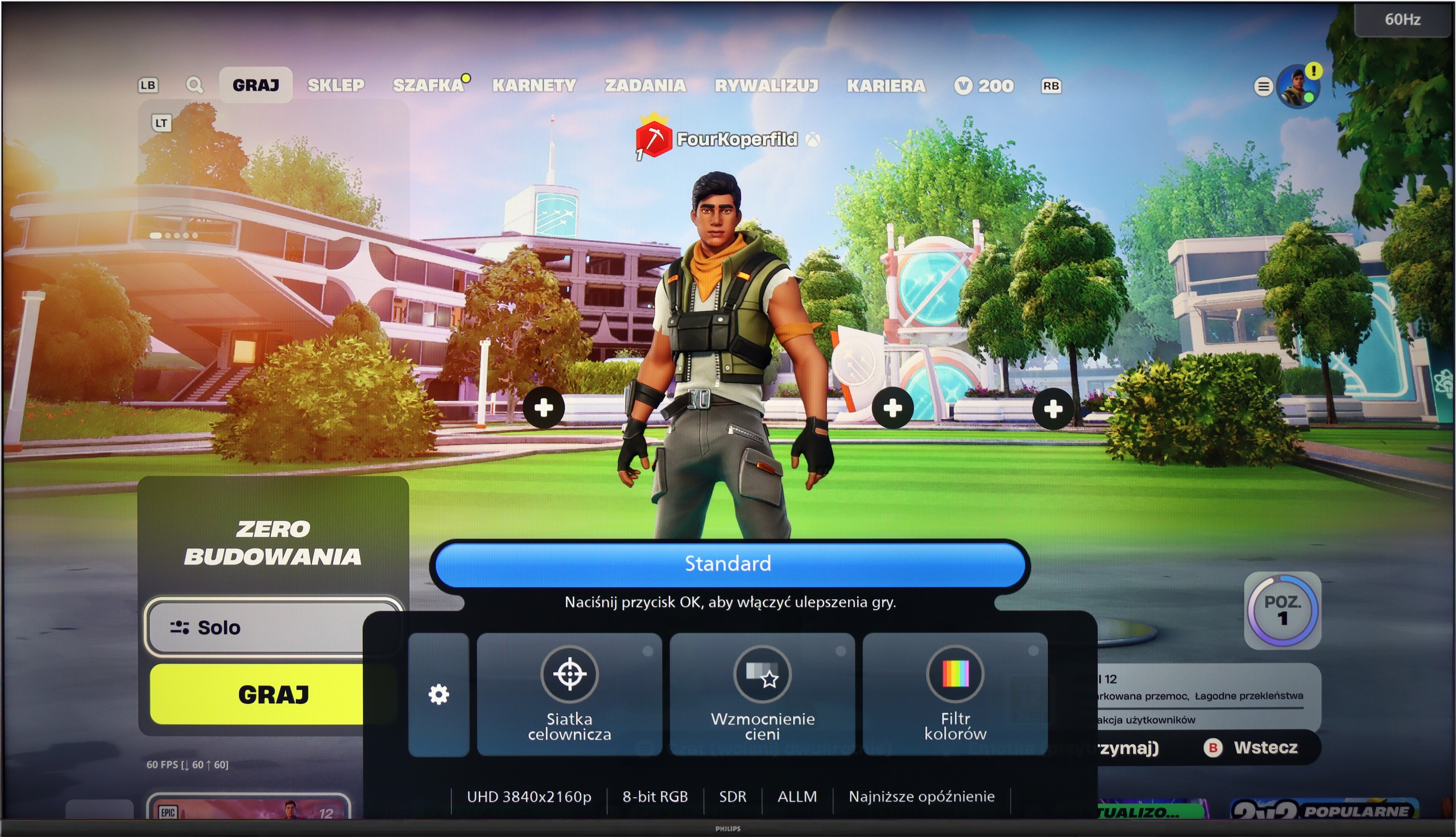

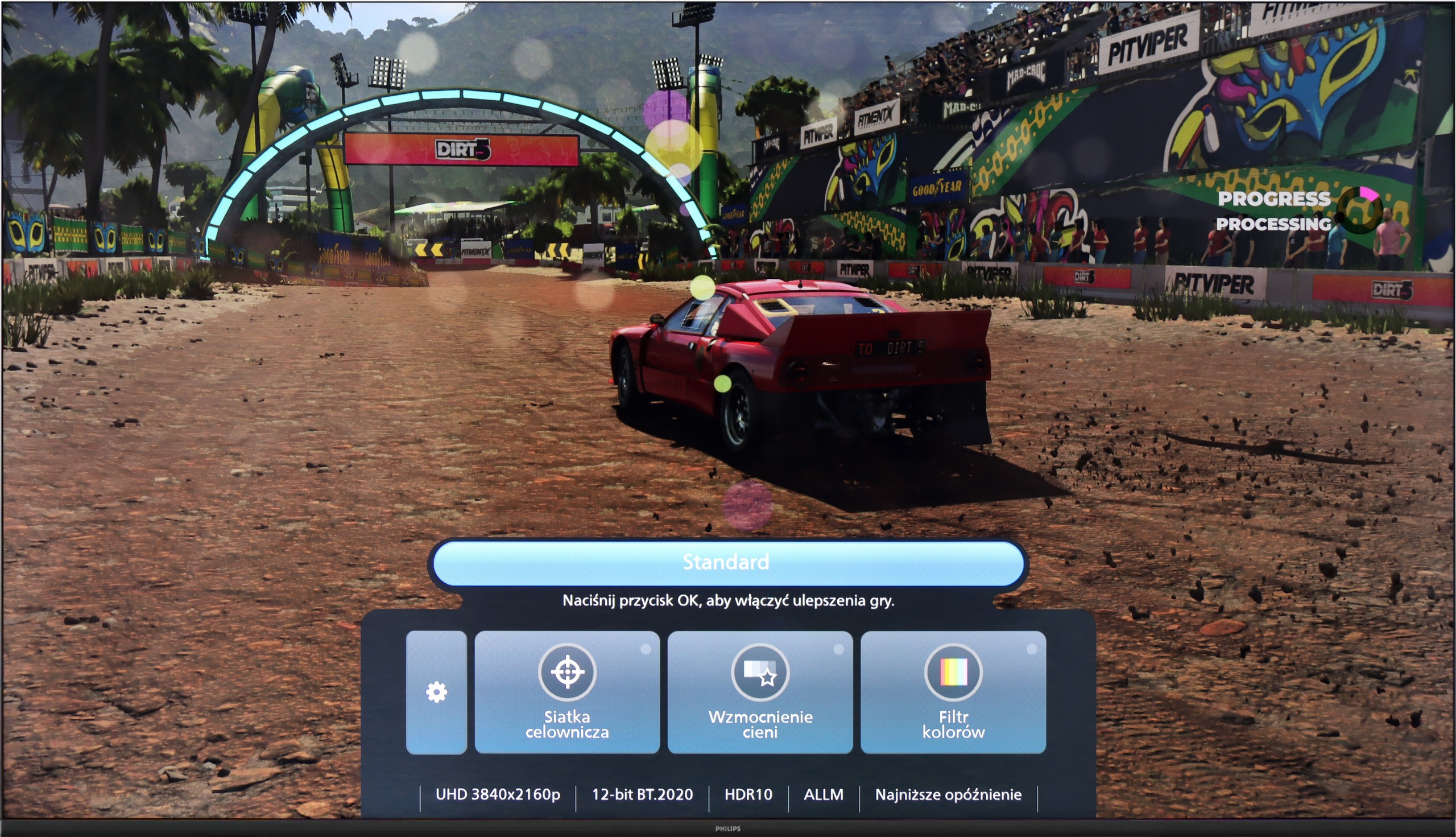
While gaming on the console, LG NANO82T offers a range of features that can significantly impact the gaming experience, although it also has some limitations. Among the advantages, it's worth mentioning the ALLM (Auto Low Latency Mode) feature, which automatically adjusts the picture settings by switching the television to low latency mode. This is particularly beneficial for gamers who need quick responses to their actions. Another plus is the support for HGiG (HDR Gaming Interest Group), as HDR games are displayed as intended by the developers, providing realistic and vivid visual effects. These features make the LG NANO82T offer a good gaming experience, although some aspects could be better, especially in dynamic scenes. Unfortunately, the LG NANO82T has its limitations when it comes to gaming features. It lacks support for variable refresh rate (VRR), which can affect the smoothness of gameplay, particularly in more dynamic games. The television has a 60Hz panel, preventing the use of higher refresh rates. This is a significant drawback for gamers who expect smoother gameplay at higher resolutions. Additionally, the lack of G-Sync technology support limits image synchronisation capabilities, which may lead to tearing and stuttering in games.
These shortcomings may mean that the LG NANO82T does not meet the expectations of the most demanding gamers who are looking for advanced features and the highest image fluidity.
Although the Philips PUS8560 is not designed with gamers in mind, the manufacturer has decided to equip it with a few features that may prove useful when connecting a console. On board, we find automatic switching to game mode (ALLM), as well as a simple connection status information bar – the so-called Game Bar. It does not make a particularly strong visual impression, but it serves its purpose. The presence of variable refresh rate (VRR), operating in the range of 48 to 60 Hz, may come as a surprise. While this is not a wide range, in the case of less demanding games or titles with unstable frame rates, VRR can help reduce screen tearing. However, this is the only element that could be considered beyond the minimum.
It must be made clear that the PUS8560 is not equipment for gamers looking for a responsive screen and full support for modern console features. It lacks HDMI 2.1 ports, the refresh rate is limited to 60 Hz, and the response time of the panel is not among the fastest. This model may be suitable at most for casual gamers who want to enjoy the Ambilight system.
Input lag
9.9/10
10/10
SDR
HDR
Dolby Vision
The input lag on the LG NANO82T is truly excellent, with a maximum value of just 15 ms. This is an impressive result that ensures a lightning-fast response to player movements. With such low latency, gameplay becomes smooth and responsive, which is crucial for gamers who value quick and precise actions. Regardless of the type of game, the television offers outstanding experiences, minimizing delays and allowing for complete immersion in the gaming world.
The input lag on the PUS8560 is very good. When we previously mentioned that this screen is rather for the "casual gamer," there is nothing to be ashamed of in this regard – even when compared to screens aimed at gamers. Results around 12 ms are truly outstanding, allowing for an enjoyable responsive gameplay experience. It doesn't matter whether we are playing in Full HD or 4K – the lag remains equally low, so if you value a quick response time, the PUS8560 will definitely not disappoint in this aspect.
Compatibility with PC
5.6/10
5.6/10

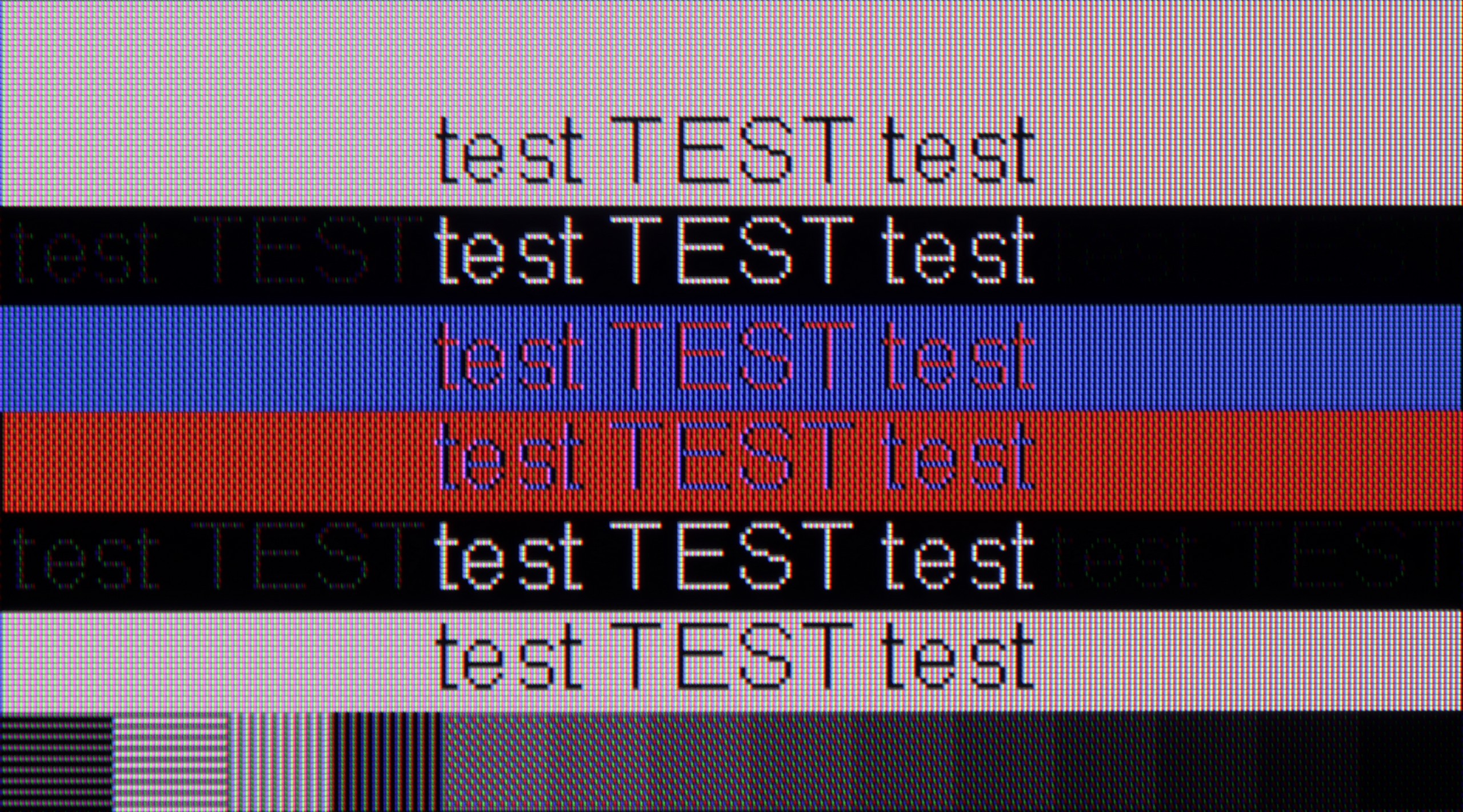
The cooperation of LG NANO82T with a computer is very good. The readability of the fonts is at a high level, which makes working with text easier. Additionally, the television supports chroma 4:4:4, providing clear and sharp details. The low input lag, at just 14 ms, ensures that all actions on the screen are smooth and responsive. This model offers a panel with a refresh rate of 60 Hz, and the lack of support for G-Sync may disappoint gamers. For this reason, the television receives a lower score in the context of gaming, although it performs reasonably well as a work monitor. Unfortunately, we deducted further points for displaying fonts on a dark green background, which can be somewhat annoying in certain cases.
When it comes to working with a PC on the PUS8560, it looks... quite strange. Chroma 4:4:4 is present in "Monitor" mode, but there is a problem with grey fonts – not all subpixels are lit, which results in the text appearing jagged. On the other hand, in "Game" mode – chroma 4:4:4 disappears, but the grey fonts look correct. In practice, we are therefore forced to juggle settings if we want to have perfectly readable text at all times. And what about gaming on the computer? Our opinion remains the same as for consoles – it is doable, but without fireworks. There is no variable refresh rate for G-SYNC graphics cards, and the refresh rate itself remains relatively low. However, we can once again highlight the very low input lag, which saves the situation in dynamic games.
Viewing angles
2.7/10
3.3/10
The viewing angles on the LG NANO82T are not the best, which is typical for budget VA panels. Colours lose their intensity, and contrast worsens when viewed from the side. Blacks become more washed out, and details less sharp. This can impact the viewing quality in larger rooms, where viewers are seated at different angles. This is one of the main drawbacks of VA panels in lower-end televisions. Although they offer better contrast and deeper blacks compared to IPS panels, the viewing angles are significantly limited. If we often watch television from various spots in the room, it may affect our visual experience.
The viewing angles on the PUS8560 are precisely what one would expect from a VA panel - it's not the best. The image loses quality even with a slight shift off-axis – colours become washed out and black begins to resemble a dark navy. This is, of course, the price paid for the better contrast that VA offers when viewed directly. In the case of our 55-inch model, this is still acceptable, especially if the television is positioned perfectly opposite the sofa. However, with larger screen sizes or a less central placement in the living room – it could become a problem for comfortable viewing.
TV efficiency during daytime
3.9/10
4.9/10

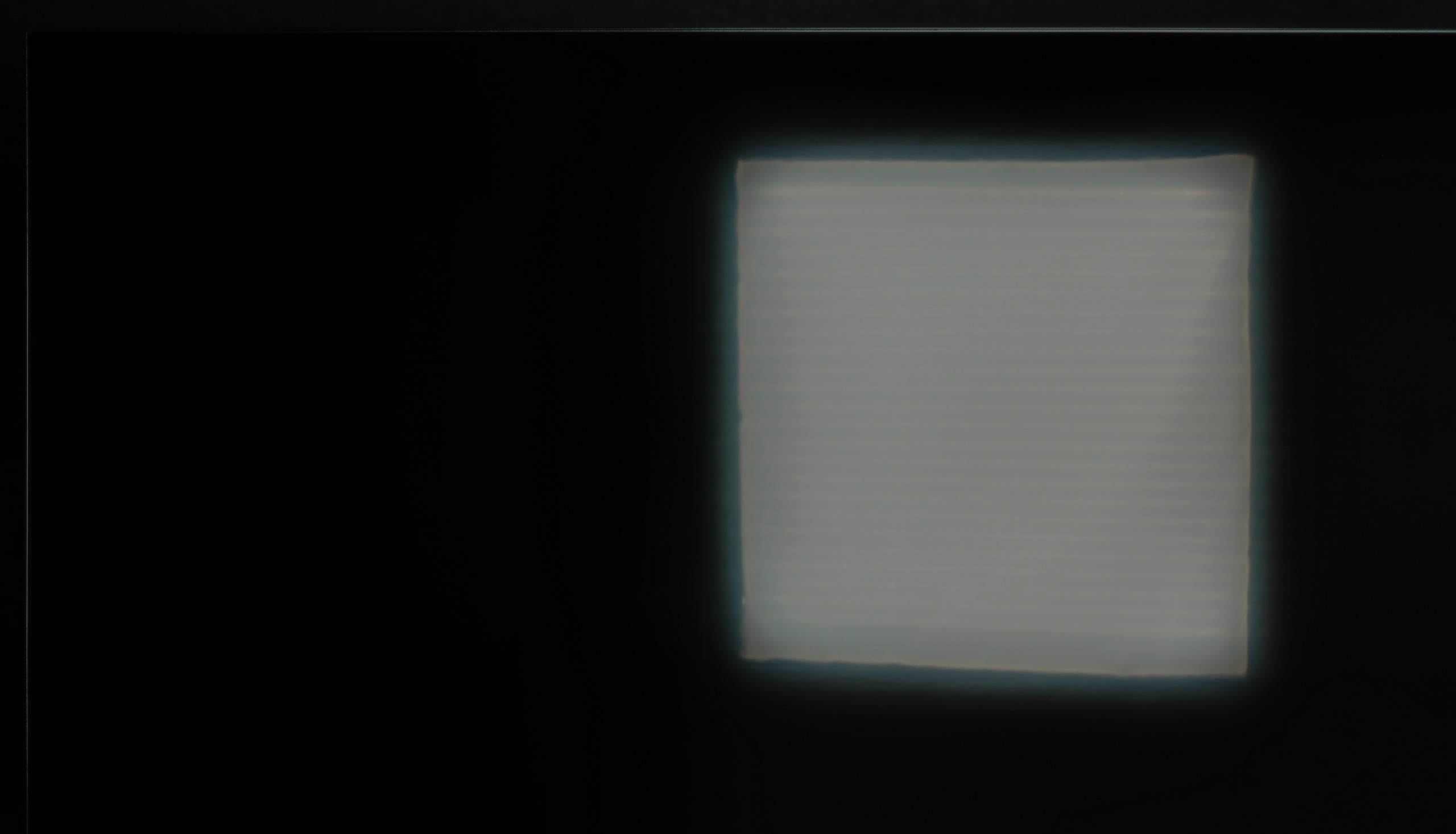

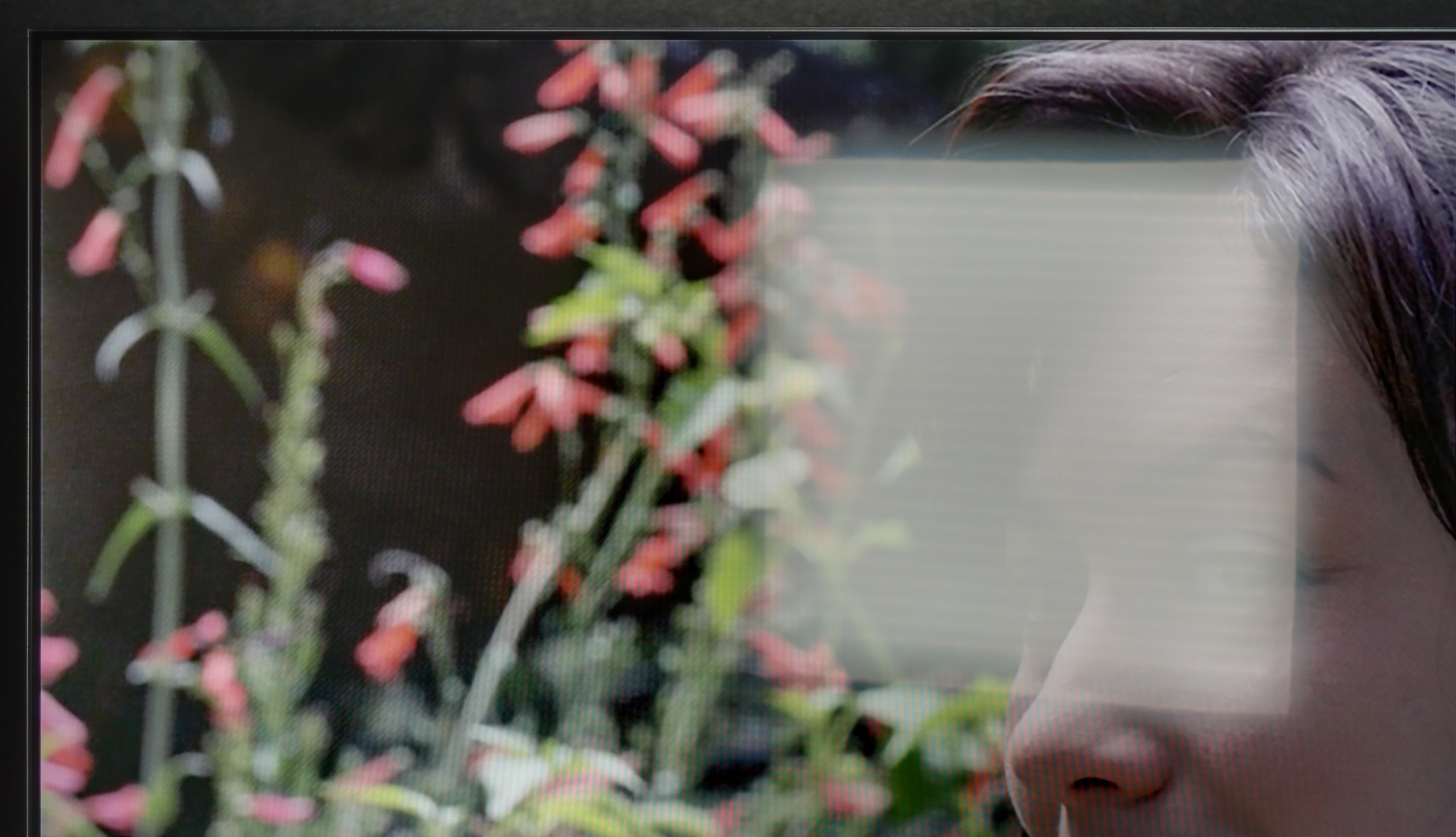
Matrix brightness
Average luminance SDR
Philips PUS8500 : 331 cd/m2
LG NANO82T6B: 259 cd/m2
In the category of daytime performance, LG NANO82T does not perform the best. The satin matrix offers average reflection suppression, which can be problematic in bright rooms. The low rating is mainly due to the very poor screen brightness of only 250 nits. As a result, the television may struggle to provide adequate image quality in well-lit environments, limiting its functionality under such conditions.
The PUS8560 performs moderately during the day. The satin matrix coating quite effectively dampens reflections, which means that light from windows or lamps does not interfere too much. The blacks also look decent for a VA panel – even in daylight, there are no significant losses in contrast. However, all the charm fades when it gets really bright. The panel's brightness is around 300 nits, which is definitely too little to speak of full comfort in a heavily lit room. In such conditions, the PUS8560 simply needs to be aided by blinds – otherwise, the image begins to look rather pale.
Details about the matrix
Subpixel Structure:

Panel uniformity:

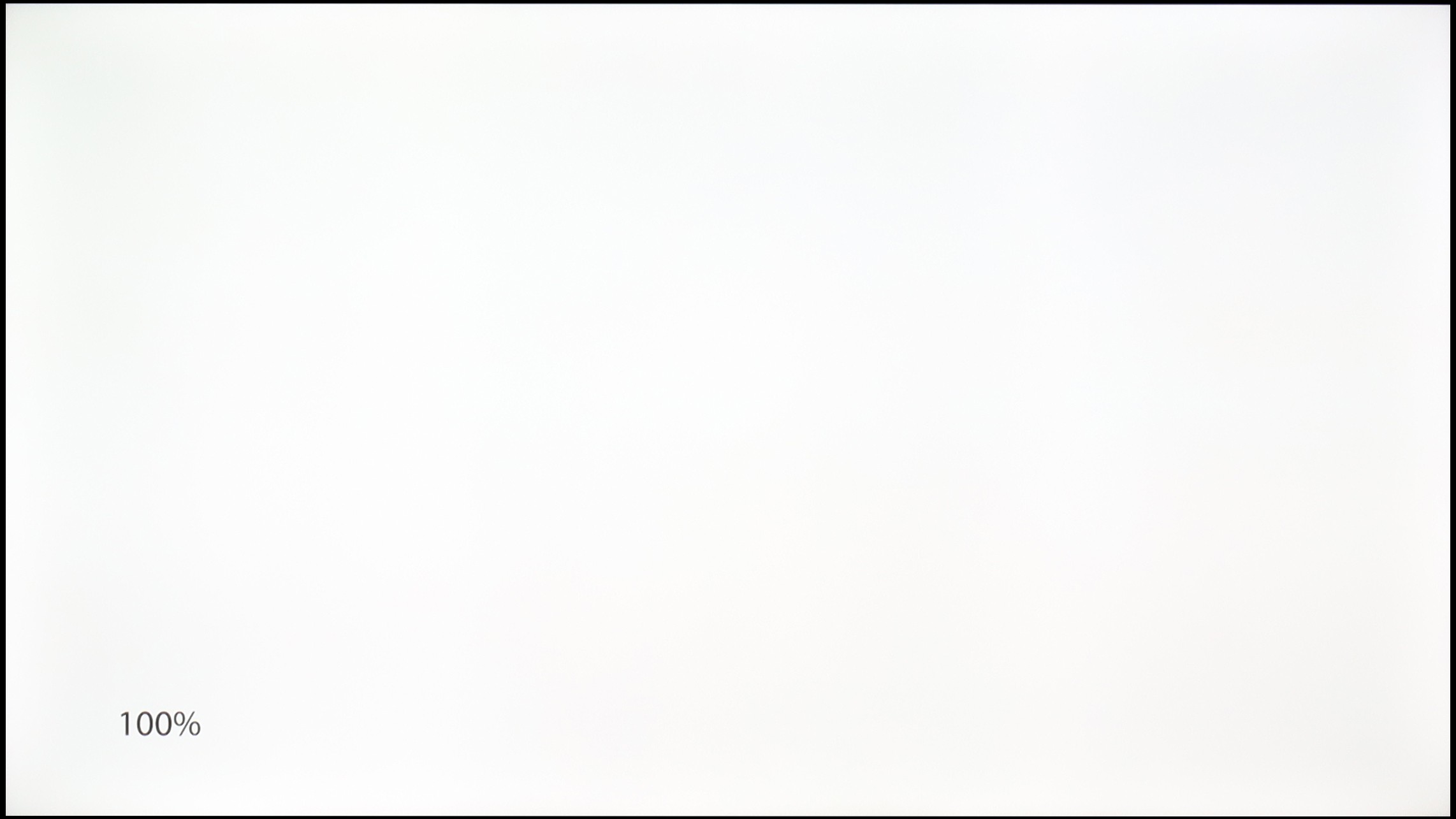
LG NANO82T6B
Philips PUS8500
TV features
8.3/10
4.9/10
- HDMI inputs3 x HDMI 2.0, 0 x HDMI 2.13 x HDMI 2.0, 0 x HDMI 2.1
- OutputsToslink (Optical audio), eARC (HDMI), ARC (HDMI)Toslink (Optical audio), eARC (HDMI), ARC (HDMI), Mini-Jack (Headphones)
- Network InterfacesWi-Fi 2.4GHz, Wi-Fi 5GHz, Ethernet (LAN) 100MbpsWi-Fi 2.4GHz, Wi-Fi 5GHz, Ethernet (LAN) 100Mbps
- TV receptionDVB-T, DVB-T2, DVB-S, DVB-S2, DVB-CDVB-T, DVB-T2, DVB-S, DVB-S2, DVB-C
Classic features:
- Recording to USB (terrestrial TV)
- Recording programming
- Picture in Picture (PiP)
- RF remote control (no need to aim at the screen)
- Backlit remote control
- Teletext
- Audio only mode
- Possibility to connect Bluetooth headphones to the TV
- Possibility to simultaneously use Bluetooth headphones and the TV speaker
Smart features:
- AirPlay
- Screen mirroring (Windows Miracast)
- Wyszukiwanie głosowe
- Voice search in native language
- Ability to connect a keyboard and mouse


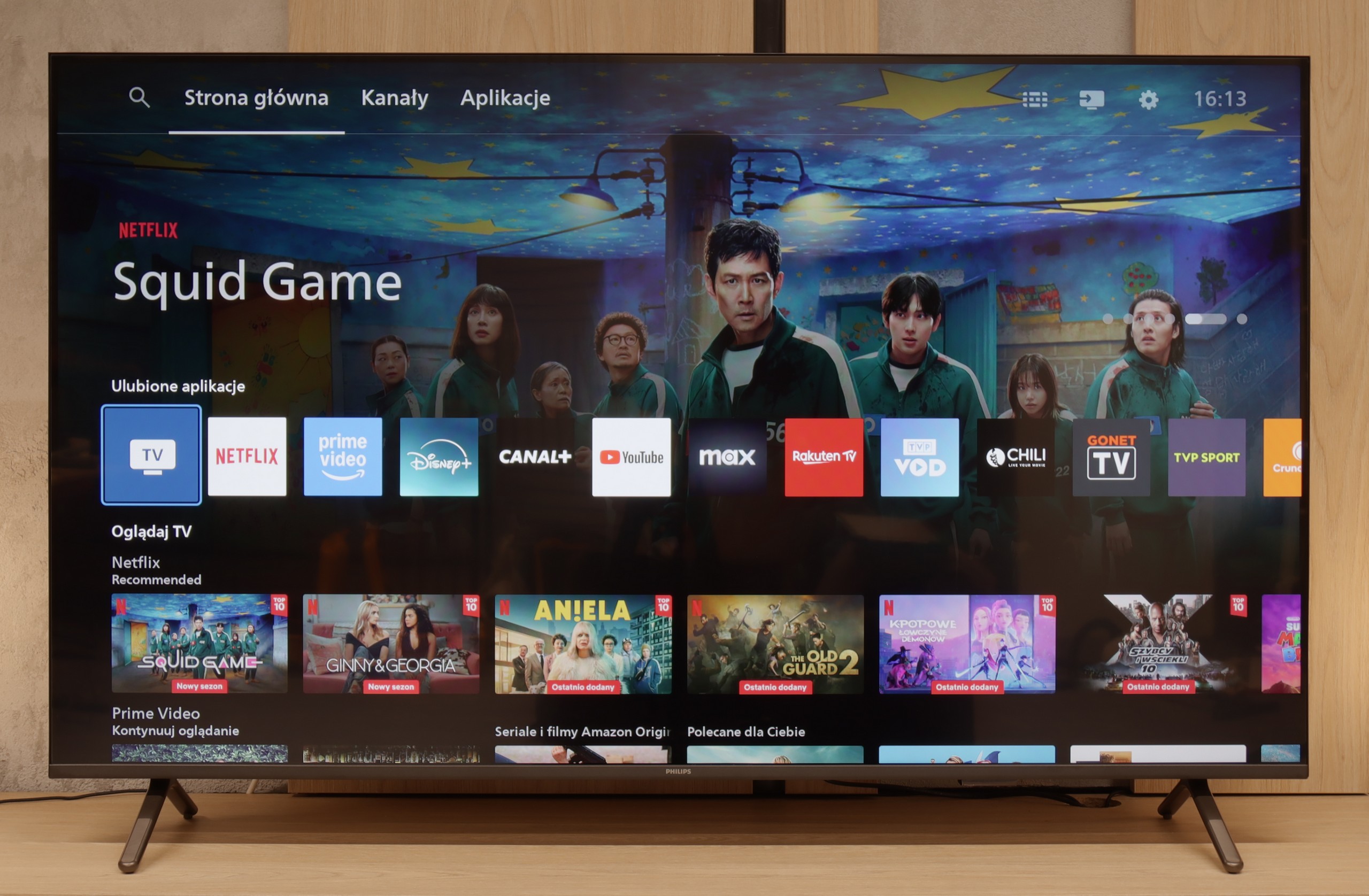
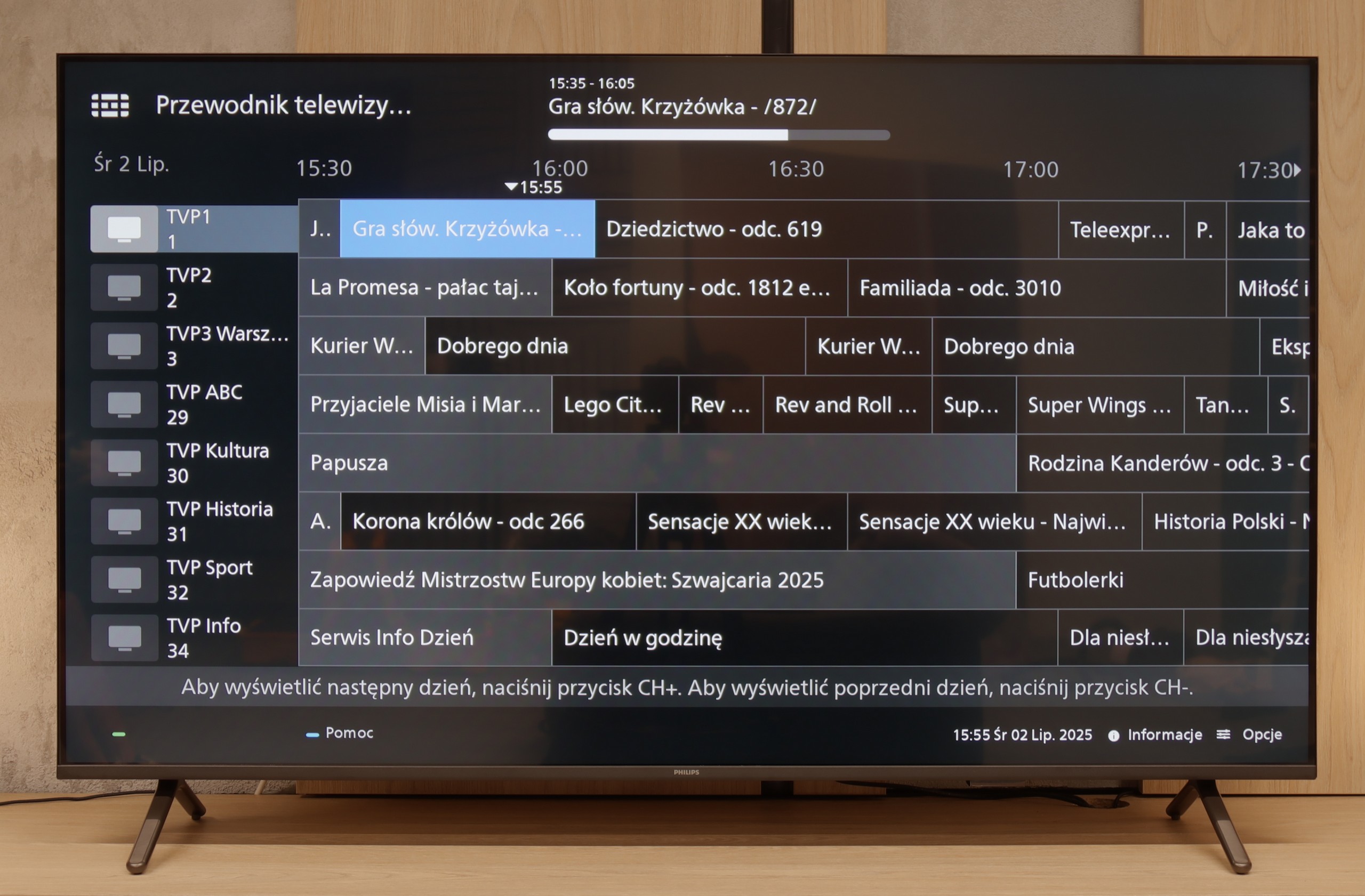
LG NANO82T offers a wide range of features that significantly enhance user comfort. The webOS operating system deserves special attention. It is intuitive, quick, and offers plenty of applications that can be easily installed and operated. The Magic Remote, or PilotMagic, is another convenience. It works like a computer mouse and allows for quick navigation through the menu. Moreover, it supports voice commands in Polish, which greatly facilitates the use of the television. WebOS also supports AirPlay, enabling easy content streaming from Apple devices such as the iPhone or iPad.
In everyday use, the television performs excellently. It is equipped with a recording function, allowing users to save their favourite programmes and watch them at a convenient time. Pairing other devices is also trouble-free thanks to the built-in Bluetooth. You can easily connect headphones, speakers, or even keyboards and mice, making the television even more versatile. However, it is worth mentioning a downside in the lack of PIP (Picture-in-Picture) functionality, which would allow for simultaneous viewing of two programmes. Despite this, the LG NANO82T is a great choice for everyday use, offering many modern and convenient features.
Classic TV Features:
If you are looking for a television that "works" in the most basic sense – the PUS8560 will fulfil that role. In terms of classic features, we have a rather minimalist set. On the plus side, there is an electronic programme guide (EPG), teletext, a backlit remote control with a classic numeric keypad, and a headphone jack input. It sounds a bit like a dream set for seniors – and there is some truth to that. However, it must be stated clearly: this is a television with very limited capabilities. We will not find recording functions from DVB tuners to USB here, nor is there a PiP mode or other conveniences known from more expensive models.
Smart TV:
How does the SmartTV perform on the PUS8560? Well, this is where it gets a bit more complicated. The PUS8560 runs on the Titan OS, which in this particular implementation posed significant problems. Some features, although present "on paper," simply did not work. For example: Wireless screen mirroring functions, such as Chromecast or Miracast – we tried to activate them from several different phones and laptops… without success. Perhaps this will be fixed in the future, but at the time of testing – it did not work. Additionally, the system's speed left much to be desired – switching between applications or home screens was simply slow. A considerable portion of the menu functions seems to be well hidden in the depths of a poorly organised system. To make matters worse, the library of available applications is quite limited. Even though the situation with applications is better than last year, it is still far from ideal. The situation tries to be salvaged by a modern remote – slim, elegant, backlit, and really well made. Unfortunately, it operates on classic infrared, so you have to aim it at the screen. The only exception is voice control, which works via Bluetooth… it’s just a pity that it doesn’t support Polish.
Playing files from USB
8.2/10
8/10
Supported photo formats:
Maximum photo resolution:

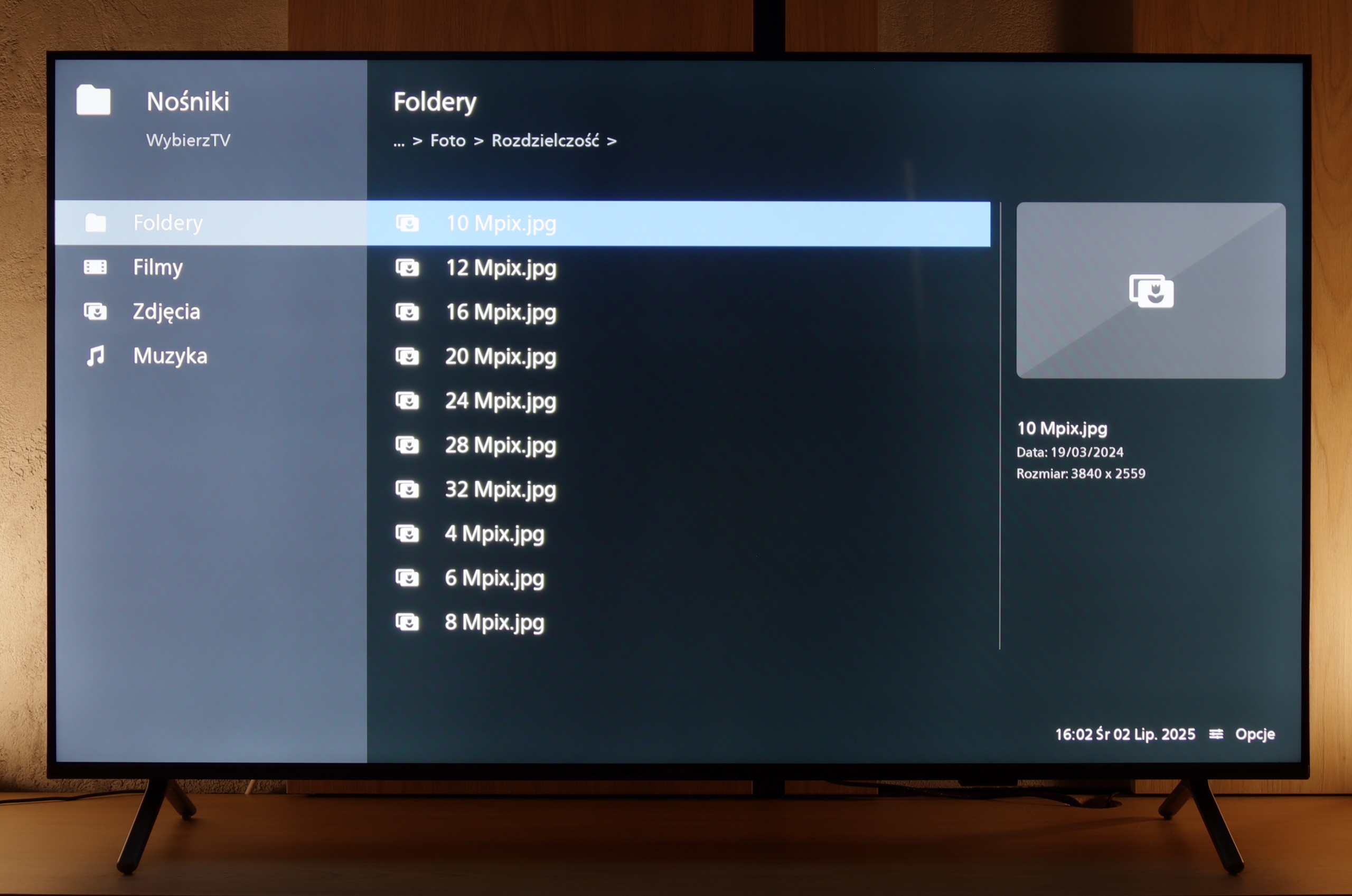
The file player in the LG NANO82T is similar to what can be found in other LG models. It will satisfy most users by offering convenient and efficient playback of a variety of video and audio files. However, more demanding users, particularly those who require support for unusual photo formats, may experience some limitations. In such cases, it is worth using a computer to achieve full compatibility with different file formats. Overall, the file player in the LG NANO82T meets its basic purpose.
The PUS8560 handles the playback of most popular video and audio formats from a USB memory stick without any major issues, so there’s no point in detailing the compatibilities one by one. In everyday use, it should simply work – and it does. The only thing worth noting is the handling of images. Although the television easily recognises popular file extensions, there are instances when some images simply do not display when the graphic files have very high resolutions. This may not be a huge problem, but it’s good to keep it in mind, especially if we want to view photographs straight from the camera. Apart from that, the PUS8560 shouldn’t pose any significant issues with playing files from USB.
Apps
9.1/10
4.6/10














































Sound
6.1/10
6.2/10
- Subjective sound quality:6.1/106.2/10
- Dolby Digital Plus 7.1:
- Dolby True HD 7.1:
- Dolby Atmos in Dolby Digital Plus (JOC):
- Dolby Atmos in Dolby True HD:
- DTS:X in DTS-HD MA:
- DTS-HD Master Audio:
The sound on the LG NANO82T may not be outstanding, but it is definitely not among the worst. The television is equipped with a typical construction of two 10W speakers placed underneath, which allows for decent sound quality during everyday use. However, the lack of DTS format support may disappoint Blu-ray users who expect the highest audio quality.
The television sounds quite pleasant and can confidently be regarded as having sufficient sound levels for most users – both for watching everyday programmes and for an evening viewing of a series. Moreover, a pleasant surprise is that even in this budget-friendly series, Philips has chosen to acquire licenses for full audio formats such as Dolby Atmos and DTS. This is great news for owners of home cinemas and soundbars, as it means full compatibility and no need to "fiddle around" with connecting external devices.


